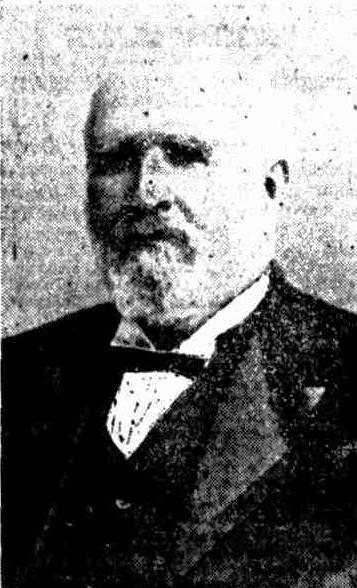The Hawkesbury River Railway Bridge: Some timely Winter Anniversaries and commemorations for a septuagenarian


At present repair works to the railway bridge across the Hawkesbury are being undertaken. Notice of which was run a few weeks back when these commenced. The works, projected to be completed in July 2018, are to piers three and four. The Marine Notice runs in full below.
The works are described as maintenance. In September 2015 a Sydney Morning Herald report drew attention to a problem with pier 2 which had been disclosed on June 6th 2013 through a report to then Rail Corporation of NSW, with a recommendation to do repairs within one year. Pier 2 was shown to have a large amount of concrete missing with parts of the reo bar exposed.
The inspection report had been commissioned to determine the extent of the observed damage. Tenders were sought and closed in May 2014. Other reports were commissioned. By December 2015 the government announced it had awarded the work to Waterway Constructions. The work was scheduled to begin in February 2016 and be completed by April.
Two independent reports confirmed that the bridge was safe to run trains. The work involved renewing the outer layer of concrete surrounding the inner core of one of the bridge’s piers. That repair and the works now being carried out bring up a few anniversaries for this great expanse across the Hawkesbury that seem to occur and have occurred around this middle part of the year.
The first bridge was opened on May 1st 1889, and the second on July 1st, 1946. In the construction of both these bridges the subject of concrete, or the strangely missing concrete even though contracted to provide the same being a prime cause for the necessity of a second one, features heavily. There was also, during the construction of the first bridge, what was called the Peats Ferry Railway Disaster, which occurred on June 21st 1888, with the loss of six lives.
The second bridge, now featured in current maintenance works, had a few links with Pittwater that are not as obvious as that of the great Hawkesbury River being a historical sister to the Pittwater estuary, which was sometimes even called part of the Hawkesbury in earlier days, and a great waterway many here still visit year round, via the river mouth that runs opposite the Barranjoey Headland and beside the West Head. It is also worth remembering many now call the Hawkesbury by her more lovely and more song-like 'Deerubbin' original (aboriginal) name.
One of these links and 'anniversaries' occurs today, only it is June 17th 79 years on, and due to that prolific raiser of obelisks, Mr. Gledhill:
NEW RAILWAY BRIDGE.
Hawkesbury River.
WORK TO BEGIN SOON.
The Commissioner for Railways, Mr. Hartigan, speaking at Brooklyn on Saturday, said that the new railway bridge to be built over the Hawkesbury River would cost about £1,500,000. The preliminary work was almost completed. When a final decision was made on the design, and money was made available, the bridge would be commenced.
Mr. Hartigan was unveiling an obelisk opposite the Brooklyn railway station to commemorate the 150th anniversary of the discovery and naming of the river in 1789 by Governor Phillip.
"Australian people abroad are ignorant of their own country," Mr. Hartigan -said. "Australian tourists are frequently asked about Australia, and many know nothing'.
"After returning recently from a world tour, I started cruises on our railways to enable people to see their own country. These cruises were so successful that we were faced with the difficulty of not having sufficient rolling stock."
Mr. P. W. Gledhill, honorary secretary of the Manly, Warringah, Pittwater, Historical Society, which erected the obelisk, said that Governor Phillip had named the river in honour of Baron Hawkesbury, then president of the Council of Trade and Plantations. The railway bridge had been opened on May 1, 1889. Its erection was a notable engineering feat. NEW RAILWAY BRIDGE. (1939, June 19 - Monday). The Sydney Morning Herald (NSW : 1842 - 1954), p. 7. Retrieved from http://nla.gov.au/nla.news-article17595213

View into the mouth of the Hawkesbury from atop Barranjoey Lighthouse tower
Jim Macken wrote an excellent book on the Japanese mini-submarines-Pittwater- Hawkesbury Bridge connection, some of which we ran in: Opportunity To Visit Submarine War Grave Renews Memories Of 75 Years Ago. That page included a great old Sydney Morning Herald article which pointed out why the first bridge needed to be replaced by the second:
Hawkesbury Bridge To Last 200 Years
By H. GORDON COLEMAN
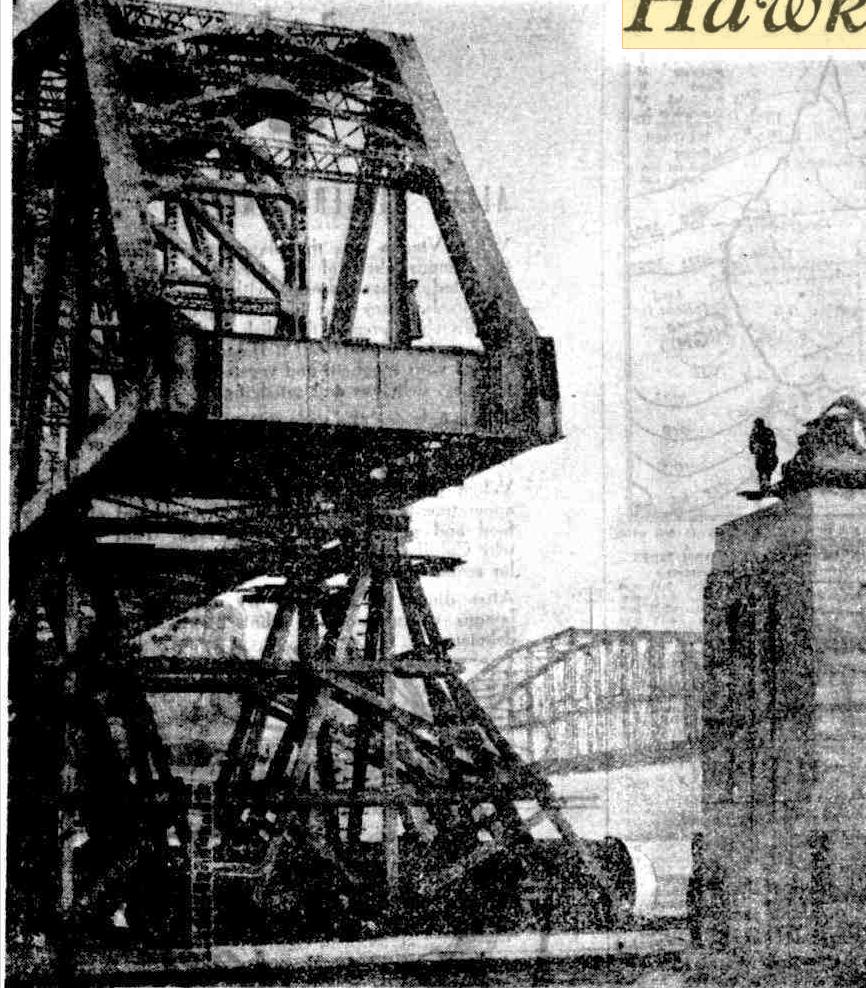
A close-up of the largest span being floated into position.
THE old Hawkesbury River bridge, built by an American firm, lasted less than 60 years. The locally designed all-Australian new bridge will have a life of at least 200 years.
A chance discovery necessitated a new bridge—a discovery which probably averted what would have been the worst railway disaster on record. A railway engineer, reading an American text book, found a statement that the interior of the piers of the Hawkesbury bridge comprised rubble.
The Chief Railway Constructional Engineer (Major-General Fewtrell) pointed out that this did not check with original specifications, which provided for metal casing on the outside and concrete on the inside, so that when the metal rusted the concrete would remain.
But the bridge had already developed an ugly pier crack, and in view of the text book statement no time was lost in scouring Australia for men who had worked on the concrete mixing board. One was found, and the information he supplied worried the engineers. They promptly set a diamond drill to work on the cracked pier. The drill made slow progress through the stone, but once below the water level it dropped into a soft substance.
SCIENTIFIC tests showed that the steel casing would have crumbled completely away in 1939, and the interior would have quickly washed out. Below water level the pier was several feet out of alignment on one side. Once daily, two express trains passed each other on the bridge, often at this pier.
To counter the defect, single-track working was introduced, and speed reduced to walking pace. The new bridge was commenced as soon as possible, and will be completed this year—the anniversary of the opening of the old bridge, 57 years ago.
Eight large tubes in the centre of each of the piers of the new bridge contain fresh water as a safeguard against deterioration.
When the piers of the old bridge became unsafe it was impossible to trace the defect until a diamond drill was used.
With the new bridge it is planned to submit water from the interior of the tubes to periodical tests. Presence of salt water would indicate the development of a fault. It is the first time in Australasia that this method has been used to detect deterioration of bridge piers.
In the construction of the piers a caisson 51ft by 29ft was built against a timber dock on the southern bank. In the centre were eight large steel tubes, which formed the centre of the caisson. Concrete was poured between the tubes, and steel used for reinforcement.
The tubes were ultimately filled with air, and the caisson, weighing 1,500 tons, and up to 35ft long, was floated from the dock to its position in the stream, where it was anchored. Air pressure in the tubes was released, and the concrete sank to a point where it was possible to pour more.
At the bottom of the caisson a 25ft high cutting edge dug into the silt on the river bed when bottom was reached. Tube caps were removed alternatively, so that a large grab, operated off a jib crane attached to a punt moored alongside the pier, could be dropped down the tubes and cut into the river bed, automatically closing as it was lifted, and dredging a hole for the caisson to settle. This was continued until the foundation was reached.
In construction of No. 7 pier, 15,500 tons of cement was used. It sank to 183ft below high water mark With the, exception of. No. 8 pier, which was constructed by the lock system, and settled on a rock foundation at 110ft, all piers were sunk to approximately 180ft.
SAND bottom was found for the piers, compared with soft mud for the old bridge. Each tube was filled with sand for half its length; a cement plug was constructed on top of the sand, and from there to sea water level the tube was filled with fresh water.
Two men lost their lives in the construction of the piers.
Each of the steel spans-six of the eight are already resting on the piers was constructed on the southern bank, where a ledge was cut out of a sandstone cliff face, and three docks were cut into the ledge at right angles to the stream. It was into these docks that pontoons which carried the spans out to the piers were floated at high tide, and allowed to drop with the tide on to the piers-45ft above high water level.
There was tension as each span was moved from the land. Work-men operated cautiously, engineers paced up and down the cliff face, and along the old bridge, others stood anxiously on the piers as the span approached down a treacherous tidal stream.
From a specially constructed '"bridge" the chief designer, Major-General Fewtrell (former G.O.C. Australian lines of communication) gave orders over the telephone, or moved up and down the timber cat walk, constructed along the, length of the span, to check all movements.
Two of the spans, 450ft long, 34ft wide, 72ft high, weighed 1,470 tons when' lifted on to the pontoons. In the construction of each 180,000 steel rivets were used. There are four spans each 375ft long, two,150ft long, and on the southern side two 75ft concrete approach spans are being built.
Two large approach tunnels made it possible to shorten the distance across water by 146ft. On the Sydney side engineers cut away sandstone to a height of 100 feet before they commenced to tunnel.
As each span was constructed on the ledge it had to be raised to pier level before the pontoons could be floated underneath to carry it away. To undertake this job two huge lifting jacks, each weighing 230 tons, and 52 feet high, were designed by young engineers-two were still studying for their diplomas--and these jacks lifted the spans 25ft in two and a half days.
It took more than two years to prepare the site and construct difficult machinery in peculiar locations. Many engineering problems had to be surmounted before, construction commenced.
As each span neared completion key men engaged in their movement were specially trained. A large board, representing the land and water at the site of the new bridge was laid down in the southern tunnel. Model piers were accurately fixed in position in the "stream," and miniature spans, pontoons, and equipment were used so that the men could practice in detail movements and prepare for emergencies likely to develop when the full-size span was transferred to the piers.
During war years the old bridge was guarded by submarine nets. When the Japanese submarines were sunk in Sydney Harbour the captain of one had a map of the Hawkesbury River in his possession. Had the bridge been destroyed there would have been no direct north-south rail link. The alternate route would have entailed travelling an additional 400 miles— via: Lithgow—Dubbo—Werris Creek. This would have seriously affected troop movements and the transport of war supplies.
THE old bridge is to be removed. Each span will be floated off the piers on the rising and falling tide and then dismantled. After general checking the steel in the seven spans will be transported to other parts of the State and re-assembled to form bridges across various waterways.
Two spans have been reserved for the crossing of the Darling River at Bourke and Billabong Creek on the proposed Bourke to Barringun rail-way, which is part of the Commonwealth's project for a north-south inland railway through the back of Queensland, linking up with a cross-country line to Darwin. Hawkesbury Bridge to Last 200 Years (1946, May 11). The Sydney Morning Herald (NSW : 1842 - 1954), p. 6. Retrieved from http://nla.gov.au/nla.news-article17980460
Major-General Fewtrell was no stranger to Pittwater:
Army Stew Popular
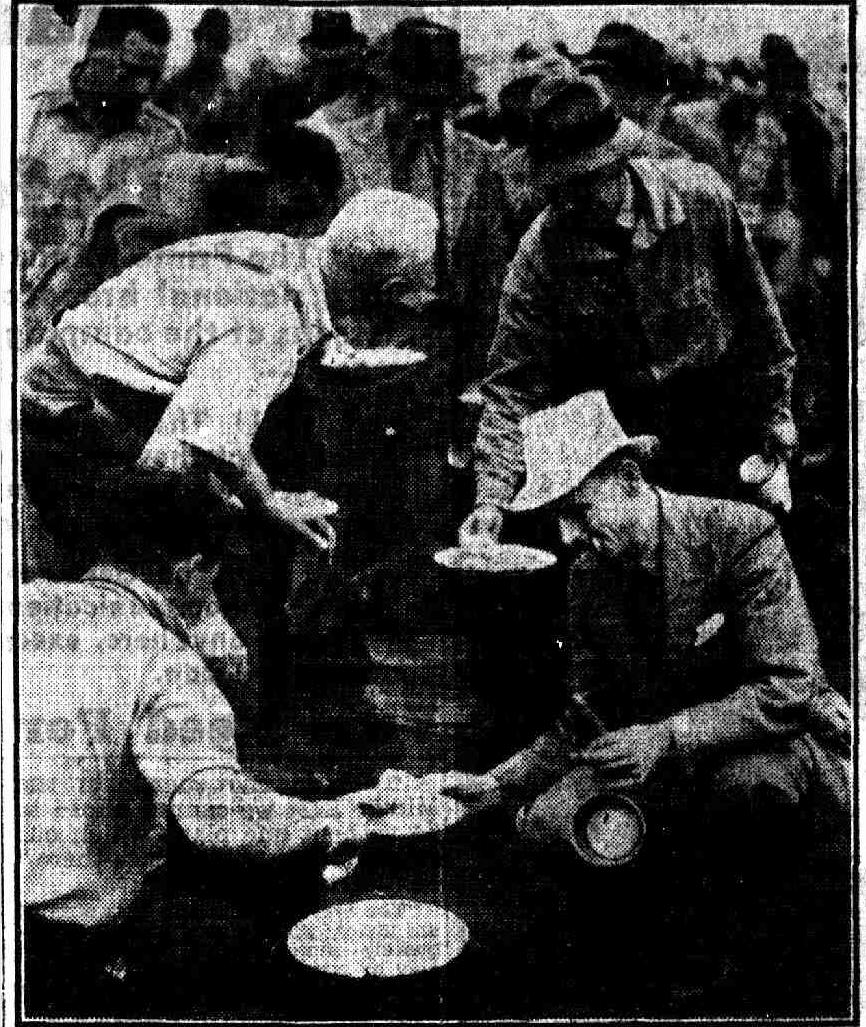
HUNGRY MEN queue up for lunch after strenuous training at the Warriewood weekend camp of the 17th Battalion, Volunteer Defence Corps (Home Guard), where they were inspected yesterday by the State Commander of the V.D.C. (Major-General Fewtrell) and the Commander of the Sydney-Port Kembla Portress Area (Brigadier-General Heane). Army Stew Popular (1941, June 9). The Daily Telegraph (Sydney, NSW : 1931 - 1954), p. 6. Retrieved from http://nla.gov.au/nla.news-article248143380
CITY HONOURS MAJOR-GENERAL FEWTRELL
The Lord Mayor, Alderman Bartley, tendered a civic luncheon, at the Town Hall yesterday, to Major-General A. C. Fewtrell, who recently relinquished command of the New South Wales Lines of Communication Area.
Those present included the Premier, Mr. McKcll, the Leader of the Opposition, Mr. Mair, Rear-Admiral Muirhead-Gould, and Major-General E. C. P. Plant, who has taken over command of the New South Wales Lines of Communication Area.
All the speakers praised Major-General Fewtrell's service to the State and his service of 35 years with the forces, during which he served both at home and abroad. CITY HONOURS MAJOR[?] GENERAL FEWTRELL (1943, October 1). The Sydney Morning Herald (NSW : 1842 - 1954), p. 4. Retrieved from http://nla.gov.au/nla.news-article17869020
 Albert Fewtrell was born on the 12th March, 1885, and died at Sydney on the 16th October, 1950. He was educated at Queensland State Schools and the Townsville Grammar School, and received his practical training as an indentured cadet under the chief mechanical engineer, Queensland Railway Department. He joined the railway construction branch of the Public Works Department, N.S.W., as an engineering draughtsman, later being appointed a resident engineer.
Albert Fewtrell was born on the 12th March, 1885, and died at Sydney on the 16th October, 1950. He was educated at Queensland State Schools and the Townsville Grammar School, and received his practical training as an indentured cadet under the chief mechanical engineer, Queensland Railway Department. He joined the railway construction branch of the Public Works Department, N.S.W., as an engineering draughtsman, later being appointed a resident engineer.
In 1909 he was commissioned in the corps of Australian Engineers, and in 1915 was mobilised to organise the Australian Engineer Training Depot for the A.I.F., and later organised and commanded the 7th Field Company A.I.F.
In 1916 he embarked as a Lieutenant-Colonel, commanding the Australian Mining Battalion, A.I.F., and in France organized and commanded the 4th Australian Pioneer Battalion. In the same year he was specially selected to organize and command the 1st Anzac Light Railway Unit. He was also Australian representative on the Headquarters of the Director-General of Transportation in France.
For his services he received the D.S.O. and was twice mentioned in Despatches. On his return to Australia, he was appointed resident engineer in charge of the Zara Street power-station construction, Newcastle, N.S.W. From 1920 to 1932 he was successively divisional engineer in charge of maintenance of the northern division, N.S.W. railways; supervising engineer for construction works ; and Transport Commissioner (Way and Works).
Towards the end of 1932, on the reorganisation of the control of the transport system in New South Wales, he was appointed chief civil engineer of the Railway Department, which post included the supervision of the design and construction of the new Hawkesbury River railway bridge, and the planning and lay-out of the Eastern Suburbs railway; he was also Chairman of the Circular Quay Supervisory Committee controlling the erection of the new railway station and overhead roadway at Circular Quay and other works associated therewith.
During the period between the two World Wars, he played an active part in the maintenance of the Defence Forces. He was awarded the Order of Companion of the Bath (Military Division) in 1938.
On the outbreak of World War II, he was chief engineer of the Eastern Command and, in 1940, was promoted to Major-General and given command of the 1st Australian Division, A.M.F. In 1941 he was responsible for the organization and manning of the coastal defences of the Newcastle, Sydney, and Wollongong areas, and from 1941 to 1943 he was General Officer commanding the Lines of Communication area of New South Wales.
He was demobilized in 1943 and resumed duties as chief civil engineer of the N.S.W. Railway Department, personally supervising the completion of the Hawkesbury River railway bridge.
Major-General Fewtrell was elected a Member of the Institution on the 4th December, 1945, and served on the N.S.W. Advisory Committee of the Council.
In 1949 he presented a Paper [1] on the new Hawkesbury River railway bridge, New South Wales, which was discussed both in London and at meetings of the various local divisions of the Institution of Engineers, Australia, and for which he was awarded a Baker Gold Medal. He was also a Member of the Institute of Transport and of the Institution of Engineers, Australia.
In February, 1910, he married Ellie Dickson Tracy, by whom he had two sons. 1. J. Instn Civ. Engrs, vol. 32, p. 419 (Oct. 1949). From - OBITUARY. MAJOR-GENERAL ALBERT CECIL FEWTRELL, 1885-1950. Journal of the Institution of Civil Engineers. Published Online: June 05, 2015 https://doi.org/10.1680/IJOTI.1951.12765
A few notes on that second bridge construction which show, in their publications across the breadth of Australia, how much interest in this grand project:
HAWKESBURY BRIDGE
Balgue Constructions Pty., Ltd., is a new company that was registered in Sydney yesterday with a capital of £100,006 in £1 shares; to acquire from George Balgue the benefits of a certain contract for the construction of a bridge over the Hawkesbury River at Peat's Ferry, and general contractors and engineers, etc. The first directors are Robert Knos and George Balgue. HAWKESBURY BRIDGE (1938, June 28).The Newcastle Sun (NSW : 1918 - 1954), p. 5. Retrieved from http://nla.gov.au/nla.news-article166701463
NEW BRIDGE OVER HAWKESBURY.
A new railway bridge will have to be built over the Hawkesbury River to replace the existing bridge (states the' Sydney 'Sun'). "We have made very careful Investigations there and it seems inevitable that a now bridge will be necessary," said the Minister for Transport (Mr. Bruxner), in a statement a few days ago. In the meantime, work necessary to make the present bridge safe is being done. Mr. Bruxner refused to indicate what a new bridge would cost, but unofficial estimates are that it would be about £500,000.
The cost of the present bridge, which was built 50 years ago, was £340,000. Having seven spans with a total length of 2900 feet, it is still one of the longest railway bridges in the world. Investigations were made when the stability of the present bridge was doubted. At present trains cross the structure at low speed. Mr. Bruxner said that the Commissioner for Railways (Mr. Hartigan) was preparing plans for a new structure. The Minister denied a report that adequate progress was not being made with construction of the road traffic bridge over the Hawkesbury to replace Peat's Ferry. This bridge, which will be 1988 feet long, will cost £341,213, and will take three years to build. "The contractors have already completed two of the pontoons, and the third is almost ready, for launching," said Mr. Bruxner. NEW BRIDGE OVER HAWKESBURY. (1939, January 10). Daily Mercury (Mackay, Qld. : 1906 - 1954), p. 8. Retrieved from http://nla.gov.au/nla.news-article168826143
HAWKESBURY BRIDGE
Repairs to the Hawkesbury Bridge have been completed and 100 men engaged paid off. Plans for a new bridge are being considered by five railway experts, and it is believed that the erection of a new bridge will begin next financial year. The present bridge still has many years or lire, it was explained last week, but the Railway Department is not prepared to incur any risk, and only slow speeds on a single line will be permitted. HAWKESBURY BRIDGE (1939, June 6).Dungog Chronicle : Durham and Gloucester Advertiser (NSW : 1894 - 1954), p. 2. Retrieved from http://nla.gov.au/nla.news-article140937173
Second Bridge: Firms and Offices Involved:
Department of Main Roads.
Balgue Constructions Pty. Ltd.
Clyde Engineering Co. Ltd.
Australia entered World War II on 3 September 1939, following the government's acceptance of the United Kingdom's declaration of war on Nazi Germany. That set back the speed of construction although some work did go on during those years. Towards the end of that conflict:
NEW HAWKESBURY BRIDGE
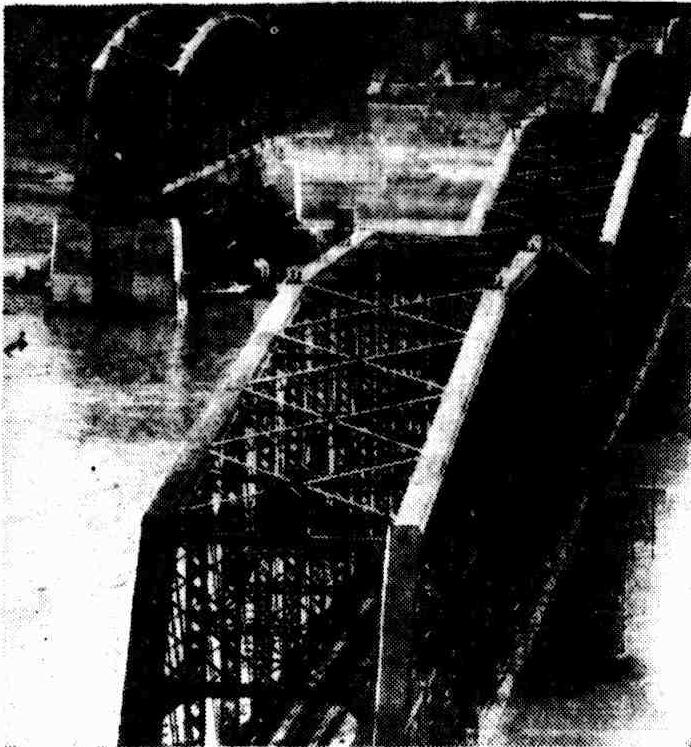
Floated on pontoons, the first of eight spans of the new Hawkesbury (NSW) rail bridge being placed in position on the full tide to come to rest on its piers as the tide falls. When completed the bridge will be the largest of its type in Australia. The span weighs 950 tons and is 347ft. 6in. in length. In the foreground is the bridge now in use. NEW HAWKESBURY BRIDGE (1944, September 18). The Mercury (Hobart, Tas. : 1860 - 1954), p. 10. Retrieved from http://nla.gov.au/nla.news-article26039439
NEW HAWKESBURY BRIDGE
GOSFORD, Wed. At high tide this morning the second span of the Hawkesbury railway bridge was put Into position, it weights 950 tons. Six other spans have yet to be constructed. NEW HAWKESBURY BRIDGE (1944, November 16 - Thursday). Daily Advertiser (Wagga Wagga, NSW : 1911 - 1954), p. 1. Retrieved from http://nla.gov.au/nla.news-article144850037
HAWKESBURY BRIDGE
Work of completing the new railway bridge across the Hawkesbury River will be advanced a further stage to-day when a small span will be placed in position. HAWKESBURY BRIDGE (1946, January 30). The Sydney Morning Herald (NSW : 1842 - 1954), p. 9. Retrieved from http://nla.gov.au/nla.news-article17968964
 NEW HAWKESBURY BRIDGE
NEW HAWKESBURY BRIDGE
GOSFORD, Friday: Weighing 1650 tons, the final big span of the new Hawkesbury Bridge was placed in position this afternoon. A span of 147 feet has yet to be erected on the northern bank of the river to complete the structure, which will then have an overall length of 2764 feet. The bridge will not be opened to traffic for several months. NEW HAWKESBURY BRIDGE (1946, April 6). Daily Advertiser (Wagga Wagga, NSW : 1911 - 1954), p. 2. Retrieved from http://nla.gov.au/nla.news-article145018912
HAWKESBURY'S NEWBRIDGE
SYDNEY, Tuesday: The Premier (Mr. McKell) will officially open the new Hawkesbury River bridge next Monday afternoon at 1 o'clock. Traffic will be diverted to the new bridge from that hour and trains
will be able to travel over It at 60 m.p.h., with several going over at a time. For several years only one train at a time used the old bridge, and speed was limited to five m.p.h. HAWKESBURY'S NEW BRIDGE (1946, June 26). Daily Advertiser (Wagga Wagga, NSW : 1911 - 1954), p. 2. Retrieved from http://nla.gov.au/nla.news-article145011749
NEW HAWKESBURY BRIDGE
The new railway bridge over the Hawkesbury River was opened by the Premier, Mr. McKell, yesterday. The picture shows Mr McKell's party crossing the last few feet in front of the train. From left: The driver, Mr. C. Fox; the fireman, Mr. Richardson; the Premier; the Minister for Transport, Mr. O'Sullivan; and the Railway Commissioner, Mr. Hartigan. NEW HAWKESBURY BRIDGE (1946, July 2). The Sydney Morning Herald (NSW : 1842 - 1954), p. 4. Retrieved from http://nla.gov.au/nla.news-article29765350
NEW RAILWAY BRIDGE OVER HAWKESBURY RIVER OPENED
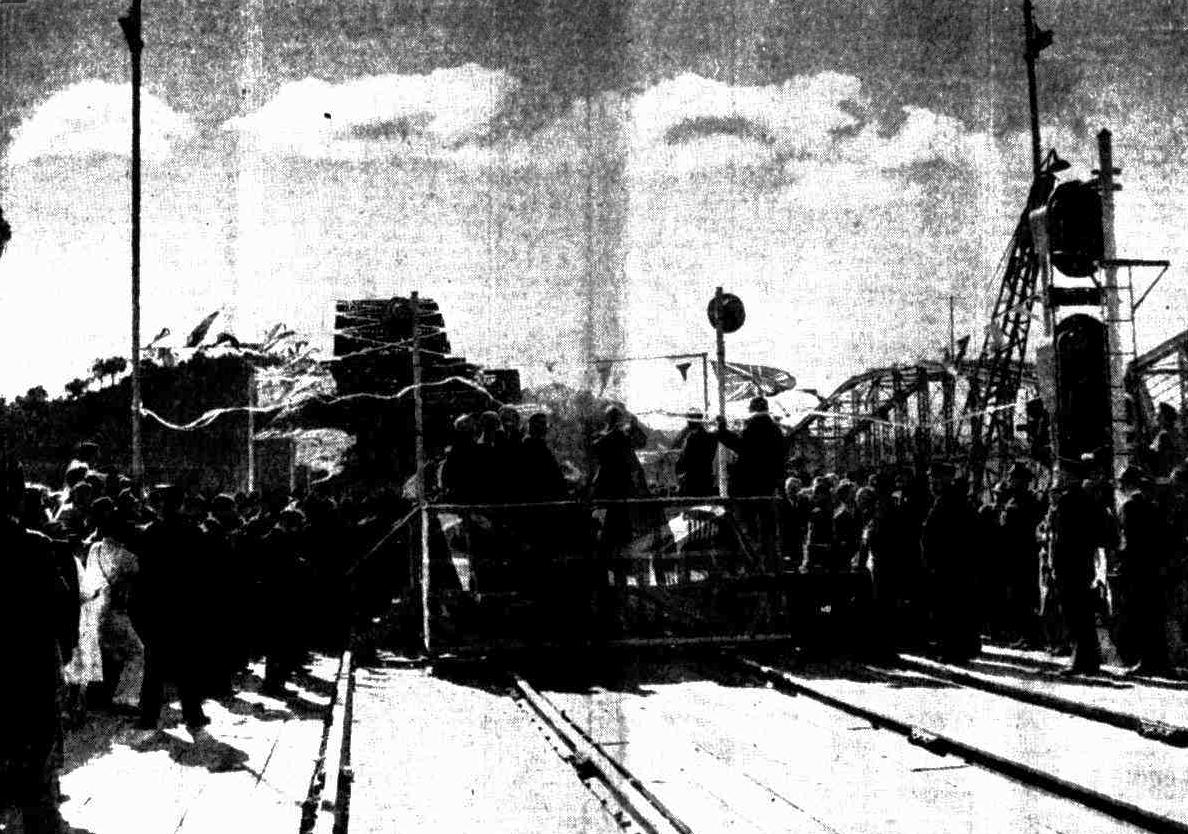
Scene at the official opening of the new railway bridge over the Hawkesbury River. This bridge is now the main link between the northeastern and southeastern quarters of the continent. NEW RAILWAY BRIDGE OVER HAWKESBURY RIVER OPENED (1946, July 3). Daily Advertiser (Wagga Wagga, NSW : 1911 - 1954), p. 1. Retrieved from http://nla.gov.au/nla.news-article145135440
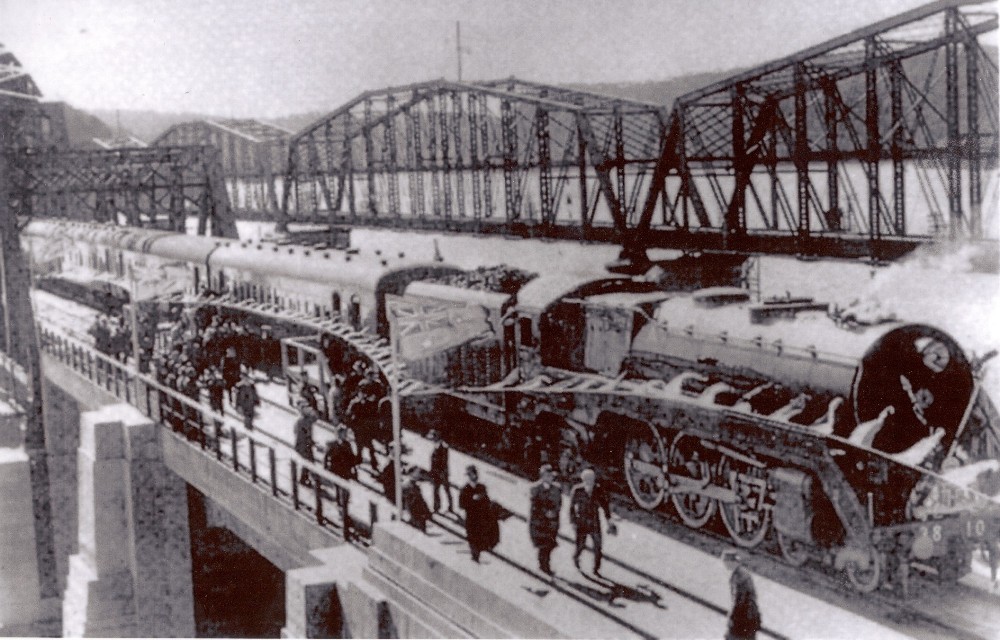
The completion of the first Hawkesbury River Railway Bridge saw the linkage not only of the significant Sydney to Newcastle Railway link but also the railway systems of South Australia, Victoria, New South Wales and Queensland as these were joined by continuous rail with the opening of the bridge.
The Bridge was used by Sir Henry Parkes as a powerful symbol of Federation and he gave the address at the opening of the bridge, which has been claimed by some as his first Federation speech. The abutments and piers of the bridge as well as the 1886 Long Island tunnel are tangible reminders of these significant events and the symbolic power they had for people at the time not only in NSW but throughout Australia. Both the 1889 and 1946 bridges and associated infrastructure on Long Island also demonstrate the significant investment in the railway system of NSW in the late nineteenth and early twentieth centuries. The workmanship of both bridges demonstrates the significant pride and confidence in the railways at the time.
The 1889 Hawkesbury River Bridge, Long Island Tunnel, Woy Woy Tunnel and the heavy earthworks and tunnels of the Cowan bank were the key engineering works on the Sydney to Newcastle rail link (The Short North). Together they demonstrate a high degree of engineering achievement in building a railway line in difficult and dangerous terrain.
The 1889 Hawkesbury River Bridge in particular was a major technical achievement at the time: it was the fourth largest bridge constructed in the world, one of its caissons reached 49m, had the deepest bridge footing in the world and it was the longest bridge in Australia. The bridge was also the first of the American designed truss bridges that were introduced to Australia in the late 1880s and 1890s and thus the first to utilise the American principles of lightweight bracing, pin joints and eye bar tension members. It was the only steel trussed bridge of its type in Australia when it was built and the first major use of steel for bridges with previous examples being built in wrought iron.
Its remains are tangible evidence of the change in engineering technology from British to American at this time and the decline of John Whitton's British based design influence on the NSW railway system.
The 1946 railway bridge was also a major technical achievement at the time of its construction, its large riveted steel trusses and its footings were still among the deepest in the world. It remains the longest purpose built rail bridge in the NSW network. The bridge itself as well as the remnant construction docks, platform and power station demonstrate the technical achievements in the construction of the bridge. [1.]
Plans for the first Bridge brought submissions from all over the world resulted in an American company being chosen:
The Hawkesbury Bridge.
The great iron bridge across the Hawkesbury River is now in a fair way of becoming an accomplished fact, all that is wanted to a beginning being the assent of Mr. Whitton and the Minister to the selected plans. The bridge will be the biggest yet built in the Australasian colonies, and the late Government very wisely decided on getting the assistance of the best engineering skill that was available. Designs and estimates were invited from all the world. These, when sent in, were submitted to a committee of three of the best experts obtainable in England. That which they thought the best was then submitted to the examination of Mr. Fowler, who is our standing consulting engineer. He acquiesced in their opinion, and it only remains now for Mr. Whitton to coincide therewith. Considering the high eminence of the engineers who have already approved the plan, it is not likely that Mr. Whitton will differ from them.
The successful competitors are a company in America. In that country iron-bridge building has been made a specialty. There are constructors and engineers who devote themselves to that, and that only. Ever since mankind instinctively adopted the plan of subdivision of labour, it has been found that those who concentrate their attention to a particular kind of work attain to a high degree of excellency ; and this is probably the reason why the Americans have carried off the prize in this competition. It is a feather in their cap to have done so, and it is a proof of their practical good sense that they have been the first to see that there was room for making bridge building a special branch of business. The agent of the company has arrived in Sydney, and is ready to go to work the moment the contract is signed, and as they know well that time means money, there will be no dawdling when the affair is once in hand. The difficulty with the bridge will not be the superstructure but -the foundations. The river is very deep, the water having scoured its channel for ages in the soft rock, and the gutter has been filled up with sand and mud. It will be necessary to go a long way down to get a firm foundation for the cylinders, and this part of the work will have to be very carefully done. When the bridge is open for traffic it will complete the link between Sydney and the Northern Railway, and every part of our railway system will then be joined together. Not only so, but it will connect us with Queensland, as the line from Tenterfield to Stanthorpe will by that time be open. It is probable, too, that the connection between Adelaide and Melbourne will have been made, and a traveller will then be able to journey with only two breaks of gauge from Adelaide to Charleville. The Hawkesbury Bridge. (1886, January 9). The Sydney Mail and New South Wales Advertiser (NSW : 1871 - 1912), p. 86. Retrieved from http://nla.gov.au/nla.news-article162814970
The Hawkesbury Bridge.
The subject of the bridge to be erected over the Hawkesbury River in connection with the Homebush to Waratah railway was brought under the notice of the Legislative Assembly on Wednesday by Mr. J. P. Abbot who impressed upon the. Minister for Works the necessity for proceeding with the erection of the bridge as quickly as possible. We understand that the Government have arrived at a decision with reference to the tenders sent in for the work of designing, constructing, and erecting the bridge, and that the tender of the Union Bridge Company of New York will be accepted if that company be willing to comply with certain necessary conditions. The Hawkesbury Bridge. (1886, January 30). The Sydney Mail and New South Wales Advertiser (NSW : 1871 - 1912), p. 245. Retrieved from http://nla.gov.au/nla.news-article162816714
VISIT TO THE HAWKESBURY.
(BY OUR OWN Reporter.)
The members of the Victorian Water Commission were taken up the Hawkesbury River on Saturday and Sunday last, as the guests of the Minister for Works, who is also President of the New South Wales Water Commission. The members of the last-named body were also invited, and about 30 members of both Houses of Parliament, the Mayor of Sydney, and several leading citizens were also in attendance. The Government steamer Ajax was utilized for the occasion, and she was fitted up with beds and bedding, about three days' supply of refreshments and food, and a number of waiters, cooks, &c.
The Ajax got under weigh about 9 a.m. on Saturday, and proceeded to Manly, where about 28 of the company elected to go overland to Newport in vehicles, provided for the purpose by the Minister for Works. The drive to the head of Pittwater was a really delightful one. The road winds through some typical Australian scenery, and for a considerable distance skirts the shore of the ocean. Narrabeen Lagoon, the scene of one of the most romantic episodes in the history of the colony, was passed, and a full view of the Ajax, steaming her way along the placid waters of the Pacific, was obtained from every hill, which the vehicles surmounted. A beautiful fern-tree gully was passed just before reaching Newport, where the Government steamer Nemesis was in waiting to convey the party down to Barranjoey Lighthouse.
Mr. Black, the Custom-house officer of the port, piloted the steamer to her destination, and a magnificent view of Lion Island was obtained when the party reached there. This remarkable-looking isle is called Eliot Island on the maps, but it is locally and more correctly known as Lion Island, for it bears a most striking resemblance to the face, head, and body of a crouched lion. As the Ajax had not arrived, the Nemesis steamed out through the Heads of Broken Bay, and sighted the Ajax, when the party returned and went on shore to see some nets hauled and inspect the light house. This is a splendid structure with a fixed red light, and the hill is reached by means of a horse tramway. On Barranjoey Head there are a number of wild goats, and some excellent sport is obtained there by gill-bird shooting. A number of fishermen are settled in huts along the shore.
The Ajax reached her anchorage about 3 o'clock, the delay having been occasioned by the fact that she was stopped several times to allow of schnapper fishing, in which the Speaker, the Minister for Works, and Mr. Targett distinguished themselves. Dinner being got over, the Nemesis party took a run up the beautiful inlet known as Cowan Creek, and the Ajax went out to sea again to allow of more fishing. Both vessels returned to Barranjoey about dark, and the Ajax then went up Pittwater to allow of the party having a sleeping place sheltered by the hills. As soon as the steamer had anchored all the company had tea, and then congregated on the quarter-deck, where a court was improvised with judge, sheriff, constables, attorney-general, and counsel for defence. A well-known public functionary was playfully indicted for a high cruse and misdemeanour, and after a most humorous trial, during which a considerable amount of forensic ability was displayed, he was acquitted, and the sheriff found guilty instead. The Victorian visitors were highly delighted with this mock trial, according to Barranjoey law, and frequently expressed the opinions, that it was the finest performance they had ever witnessed. Then followed a concert and display of recitative powers, which evoked a considerable amount of musical and histrionic talent, and lasted well into midnight, something like about forty performers taking part in the affair. Then the party turned into bed, scattered all over the deck of the ship. At daybreak, most of the party were up and refreshed, and breakfast was soon over. To their great dismay, however, the Nemesis was seen ashore on the beach, and one of the city members, who has distinguished himself as a captain before, was reported to have wrecked her. The Ajax then got under weigh for the Hawkesbury, and soon glided into its smooth waters. The bold and picturesque scenery of the Australian Rhine was the theme of continued admiration on the part of the visitors, and they frequently gave vent to their delight at its inspection.
Arrived at the railway works, near Mullet Creek, most of the party landed, and inspected the embankment and tunnel, returning in time for breakfast. Soon afterwards the Ajax slowly wended her way up the river, passing at least a dozen islands en route. Wiseman's Ferry was reached about 3 p.m., and here a halt was made for dinner. About half the party landed and inspected the ruined and roofless church, an open vault in which still stand the coffins of Mr. Wiseman and another early settler. The Macdonald River junctions with the Hawkesbury here, and the telegraph wires are taken from a pole on the south side of the last named river to the top of the hill opposite--a distance of 1600 yards-without a single break. The Court-house Rock, a startling natural feature, where, in olden times, the convicts were tried and sentenced in the open air, was also inspected, and the Minister for Works ascertained by telegraph that the Nemesis had floated off with the high tide, and was fast coming up the river. Dinner was again negotiated, and there being a flood-tide, the Ajax went straight up the river to Sackville Reach, about 12 miles from Windsor, and the head of navigation for large steamers.
Some magnificent orangeries, pumpkin beds, and maize-fields were passed on the way, and the scenery from Wiseman's Ferry to the port may truly be said to be of the most picturesque and beautiful character. On arrival at Sackville Reach four vehicles were found in waiting, and the greater portion of the party went overland to Windsor, and passing Pitt Town, Wilberforce and other hamlets on the way. In the town of Windsor, a lynx-eyed functionary of the law rushed out, and, stopping the horses of the vehicle, in turn took down the names of the drivers for prosecution next morning, for travelling without lights. A special train was in readiness to take the party down to Sydney, and the metropolis was reached about half-past 8p.m., after one of the most enjoyable excursions ever held in New South Wales. The remainder of the party returned to Sydney by the Ajax, which picked up the delinquent member for West Sydney, and reached the Circular Quay before half-past two this morning. VISIT TO THE HAWKESBURY. (1886, May 10). Globe (Sydney, NSW : 1885 - 1886), p. 8 Edition: FIRST EDITION and EVENING. Retrieved from http://nla.gov.au/nla.news-article102564739
The Hawkesbury Bridge.
Fancy a bridge constructed on piers the height of our Post Office tower. And yet that is about the height of the piers on which the Hawkesbury Bridge is to be constructed, as the following description will show. Tho contract for tho work, as our readers are aware, has been lot to the Union Bridge Company of New York. For our designs we are indebted to the Scientific American, a journal published in New York.
In November, 1884, the Government of New South Wales invited bridge builders throughout the world to send plans and tenders for building a double track steel railway bridge across the Hawkesbury River. This resulted in bids from firms in the United States, Canada, Belgium, France, England, Scotland, and Australia. The plans were referred to a commission of three eminent English engineers, who decided that although several of the plans for the superstructure were meritorious enough to warrant selection, the plans of the Union Bridge Company of New York, for the foundations, were the only ones that could be recommended.
The bridge will have a total length of 2896 feet, composed of five spans of 416 feet each between centres of piers, and two spans of 408 feet each. The width will be 28 feet between centers of trusses, the design of which is shown in the accompanying perspective view of the completed structure. All of the superstructure is to be of mild steel, having an ultimate tensile strength of not less than 67,000 pounds and not more than 73,920 pounds per square inch of section. One of the requisites is that when heated to a cherry red and cooled in water of 82*, the test pieces, cut cither lengthwise or crosswise from the material, must bend double without flaw or crack to a curve having an inner radius of 1£ times the thickness of the plates.
The location of the bridge is one that demanded extraordinary work, not in regard to the superstructure, but in relation to the foundations for the piers. The bed of the river is made up of mud and soft sand, hard gravel being reached at*a depth of 185 feet below high water, and as the rails are to be 42 feet above high water the total height from the bottom of the piers to the rails will be 227 feet. Sinking piers to such a great depth has never been attempted, even in this age of wonderful engineering, and on this account principally the methods to be pursued have attracted much attention both in America and Europe. The following description of how the work is to be done will, therefore, prove to be of interest. Like most of the methods of American engineers when called upon to perform an unprecedented work of great difficulty, the chief characteristic of these plans, as now contemplated, is simplicity.
The principle governing this undertaking can be readily illustrated by- anyone. Take 'two pasteboard tubes, one about one-half the diameter of the other, and arrange them concentrically with the lower edge of the small one a short distance above the lower edge of the large one, and then join the lower edges of both tubes with a piece of pasteboard. This will form a thick cylinder, having a central opening flaring at the bottom. If this be inserted, flaring end down, in a bucket filled two-thirds with sand and full of water, it mil be found to be next to impossible to push the cylinder to the bottom of the bucket ; but if the annular space between the two tubes be filled with sand, and then the sand be scooped out from the inside of the little tube, the cylinder will gradually sink to the bottom of its own accord. This is precisely what will be done in sinking the foundations for the Hawkesbury bridge, and what was done in sinking the foundations, to a depth of 125 feet, of the Atchafalaya bridge as the Texas and Pacific Railroad three years ago. The outer tube in this instance is oblong in plan, being 20 feet wide by 48 feet long. It is mado of boiler plate, three-eighths of an inch thick, and the edges of the several sections are brought together and riveted to a T-bar placed upon the interior, thus making the exterior perfectly smooth and free from off-sets.
At a point 20 feet from the bottom the tube begins to flare, and the lower edge is two feet larger all round than the upper portion. Upon the outside of the bottom is secured a steel plate or cutting shoe, one inch thick, two feet deep, and projecting six inches below the edge of the tube; the lower edge of the shoe is sharpened. Within the outer tube are placed, at equal distances apart, three cylinders or dredging tribes, eight feet in diameter, made of £-inch iron, and united in the same manner as the outer one. The lower part of these tubes is extended to meet the cutting edge, and the inner and outer tubes are rigidly united by a system of bracing, as shown in Fig. 1, which also represents the bucket to be used. The space between these tubes will be filled as the cylinder sinks with concrete mixed in the following proportion : 1 Portland cement, 2 sand, 3 gravel, and 4 broken stone. After the cylinder has reached a solid resting-place, the three inner dredging tubes will also be filled with cement, thus making a pier of solid cement from the bottom to the water level. From low water up, the piers will be of cut stone masonry. In the sectional elevation, Fig. 3, A is a view at right angles, and B a view parallel with the axis of the bridge. Mixing cement will be done by machinery placed upon a float anchored alongside of the pier.
The mixer consists of a square box 16 feet long, provided at each end with an outer ring or collar, which rests upon rollers. A toothed wheel at the outer end meshes with a pinion driven by an engine. The revolution of this box thoroughly ... the sand and cement, which are introduced through a curved chute leading from a hopper on a platform just above the box. 'The requisite quantity of water is admitted at the same time. The mixed cement falls from the outer end into buckets, which are carried by cranes where needed on the pier and dumped.
During the sinking of the piers it is not expected to encounter any formidable obstruction such as a large rock.Trunks of trees may be met, but their presence would not hinder the work in the least, since the great weight of the pier would force the cutting edge of the shoe through, them. The contract price of the bridge is £327,000. The contract for sinking the piers has been let to Messrs. Anderson and Barr, of New York, who superintended the erection of the Atchafalaya bridge.OUR ILLUSTRATIONS. (1886, July 10). The Sydney Mail and New South Wales Advertiser (NSW : 1871 - 1912), p. 62. Retrieved from http://nla.gov.au/nla.news-article164380945
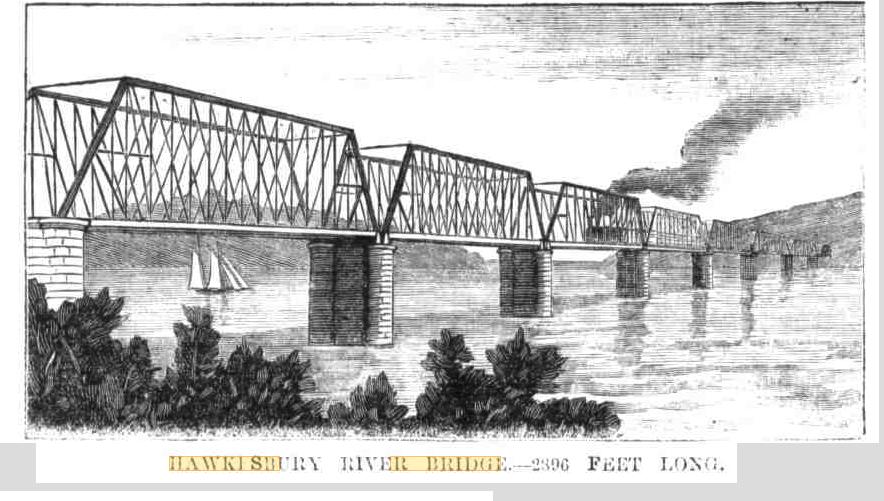
HAWKESBURY RIVER BRIDGE.—2396 FEET LONG.
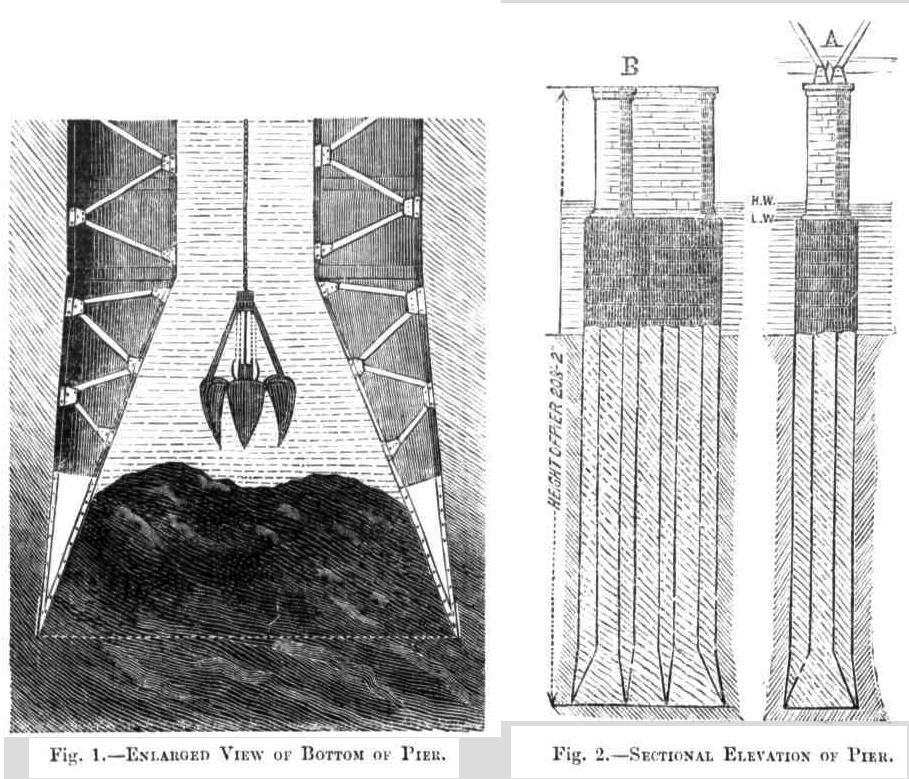
Fig. 1.—ENLARGED VIEW OF BOTTOM OF PIER. Fig. 2.—SECTIONAL ELEVATION OF PIER.

SINKING THE PIERS FOR THE HAWKESBURY RIVER BRIDGE.—THE DEEPEST FOUNDATION IN THE WORLD.
Items. (1886, July 10). The Sydney Mail and New South Wales Advertiser (NSW : 1871 - 1912), p. 75. Retrieved from http://nla.gov.au/nla.news-article164380876
The Hawkesbury Bridge.
We learn that the work of putting together the first caisson intended for the foundation of the Hawkesbury Bridge is being rapidly proceeded with at Dangar Island, where the representatives of the Union Bridge Company have constructed wharf and erected the necessary plant. The material for the second caisson is expected shortly. These portions of the foundation consist of steel plates, which are joined and then towed into position and sunk, or, to use the technical expression, 'founded to their beatings.'GENERAL NEWS. (1886, October 23). The Sydney Mail and New South Wales Advertiser (NSW : 1871 - 1912), p. 857. Retrieved from http://nla.gov.au/nla.news-article164381112
On Tuesday the 21st of June 1887, a day that was a holiday in celebration of the Golden Jubilee of Queen Victoria (the fiftieth anniversary of the ascension of Queen Victoria to the throne) a disaster that could have been greater occurred. This happened on a section of the line that had been opened only a few months.
The section between Hornsby and Hawkesbury, of 15 miles, was opened on the 7th of April, 1887, and the longer section, that between Gosford and Waratah of 50 miles was opened on the 15th of August of the same year. On the 16th of January that portion between Mullet Creek and Gosford— a distance of 10 miles— was thrown open for traffic. OPENING OF THE HAWKESBURY BRIDGE. (1889, May 2). The Sydney Morning Herald (NSW : 1842 - 1954), p. 7. Retrieved from http://nla.gov.au/nla.news-article13744427
An excursion train from Sydney ran out of control down the steep Cowan Bank. There were two other trains full of holidaymakers standing at the platforms at Hawksesbury River station and disaster was only averted by the alert station master who could hear the roaring engine and frantic whistling. He dispatched a railway porter to throw the points lever open and divert the runaway down a siding that led to the new bridge site. The train lost speed along the railway causeway out to Long Island and collided with some empty wagons. The locomotive slid off the embankment and ended up partially submerged in the river. The engine driver was trapped in the cabin and drowned but the fireman escaped.
Hawkesbury River railway station is located on the Main Northern line in New South Wales, Australia. It serves the town of Brooklyn on the Hawkesbury River.
The station opened on 7 April 1887 initially as Hawkesbury River, although the station boards apparently carried the name Flat Rock. Timetables in 1889 showed Brooklyn, but in 1890 the name reverted to Hawkesbury River.
In 1891 the station name was truncated to Hawkesbury, before the final name change back to Hawkesbury River in October 1906. Reflecting the confusion in the timetables, the station was known locally as Peats Ferry, Flat Rock, and Brooklyn in the early years, depending on whom one spoke to.
FEARFUL RAILWAY DISASTER AT PEAT'S FERRY.
FIVE PERSONS KILLED— MANY INJURED.
A terrible railway accident occurred on the Homebush-Waratah line on Tuesday afternoon, resulting in a lamentable destruction of life and property. It appears that an excursion train which left Sydney at 10.25 a.m. for the Hawkesbury River collided with some contractor's trucks of an unfinished portion of the line at Peat's Ferry at half-past 2, with the result that fearful injury was done to the rolling-stock. When the train left Redfern Station in the morning it was filled with about 400 excursionists, who were bent upon enjoying themselves on the Hawkesbury.
Everything appears to have gone on smoothly until Ryde was reached, and then it was thought by many of those who were in the train that the engine was not sufficiently strong to draw the train, which consisted of nine carriages, exclusive of the locomotive, up some steep gradients. Two of the carriages appear to have been left behind at Beecroft, and the train then proceeded as far as Hornsby; and having arrived at that place, the engine was detached, and sent back to pick up the cars that had been left behind. After a while they reached the station at Hornsby, and at that place the train was, to use a railway term, 'made up,' i.e., the two sections of the train were joined together preparatory to starting for the terminal point of the railway at the Hawkesbury.
Everything being ready, the train, which was then very late, moved out of the Hornsby station towards Peat's Ferry, and the holiday-makers, who had, to say the least of it, made the best of their lot notwithstanding the delay that had occurred, began to look forward to spending a few pleasant hours in the vicinity of the river. Many of those in the train gave themselves up to the festivities incident to the Jubilee celebrations, and snatches of well-known songs sounded out merrily as the train, bearing its precious human freight, moved onwards towards the tunnel and the incline which leads downward right to the river's brink. But suddenly there was a great increase of speed, and as the train emerged from the tunnel the driver appeared to have lost all control over it. From the official account of the accident it will be seen that the cause is ascribed to the failure of the Westinghouse air brake, and from all that can be learned of the circumstances of the disaster this would appear to have been really the case. The driver evidently knew that some disaster was likely to happen, and as the train sped down the incline at an ever increasing rate he sounded his whistle continuously. The train oscillated violently, and the passengers grew thoroughly alarmed as the pace became terrific. Very soon the train was travelling with what seemed lightning-like rapidity, raising a cloud of dust, and as it was all the time approaching the river, to which the descent for some miles is continuous, a disaster seemed inevitable. At one point it is asserted that the train attained a velocity of something like 70 miles an hour. It is said that the driver made a gallant attempt to save his charge from utter ruin by reversing his engine, but it was all too late, for no human agency could withstand the frightful rush of the carriages as they swept on and on to apparent destruction. It is said that the guard Clissold put on the brakes, but from various reasons they were rendered completely powerless, and the train sped down the incline with a thundering clatter and a dreadful rush.
Before it reached the Peat's Ferry station, however, a pointsman or porter in the employ of the Government rushed to the points, and, holding to them bravely, he managed to ' throw' the train on to a siding on which were two contractor's trucks and an engine. It was exceedingly fortunate that the pointsman had the presence of mind to act as he did, otherwise the engine and the whole of the cars attached to it would in all probability have dashed into a train which was drawn up on the line near the Peat's Ferry station, or else the train would have fallen into the river, and as a consequence a much greater loss of life would have occurred. As it was, however, the runaway train directly it was diverted onto the siding, dashed into the contractor's trucks, which were standing there, with terrific force, and almost in an instant the first and second carriages were 'telescoped,' and shrieks of agony and terror resounded on every side. The engine toppled over the side of the embankment shortly afterwards, and fell into the mud at the edge of one of the inlets of the river. The engine-driver, Thomas Wilson, went into the river with his locomotive, and was buried beneath the ponderous iron mass.
LIST OF THOSE KILLED.
T. Wilson, engine-driver. Mr. Rennie, manager for Amos Brothers, contractors. Eliza Ann Waters, of Petersham. Thomas Phillips, plasterer, of Petersham. H. Hankins, clerk in Railway Store Department, Eveleigh. The young man Hankins, mentioned above as among the killed did not die until after he had been admitted into the Sydney Hospital. His injuries were chiefly internal. He had been about three years in the railway service, and was a member of the departmental ambulance corps. His father is a boot and shoe merchant carrying on business in the Sydney Arcade.
LIST OF THE INJURED.
Harold Barry, four years old, right arm broken. Miss Eliza Hunter, May-street, St. Peters; combined fracture of the left leg and severe lacerated wound on the left thigh; in a state of collapse and not expected to live. Leg will have to be amputated, but cannot be done unless reaction sets in. Mrs. Blomgren, Hyde Park Observatory, 219 Elizabeth-street, Sydney; contused wound under chin and contusions on right shoulder. Miss Charlotte Blomgren (daughter of the above); dislocation of right hip and fracture of left arm. Miss Sarah Blomgren (sister of the above); slightly injured. Joseph W. Bannister, 27, residing at 21 Maystreet Pyrmont; sprained ankle and bruised knee. Charles Potter, 45, 7 Derwent-street, Glebe; severe shaking and compound fracture of the left leg. Mrs. Potter (wife of the above); contusion of both legs and a good deal shaken.
Jas. T. Thornton, 123 Lachlan-street, Waterloo; injury to shoulder. John Pye, of Petersham, fireman of the train; cut on scalp and abrasions on back.
Harold A. Bishop Brown, of Ashfield; deep cut on right cheek. Charles Maillay, of Woollahra; graze on shin. Miss Chantler, of 36 Wynyard-square, Sydney; severe fracture of left leg. Sydney Conyers, about 26, residing in Wynyard square, and employed in Existing Lines of Railways Department; fracture of right leg. George A. Bailey, 60, of 135 Queen-street, Woollahra; considerably shaken. Miss Elizabeth Crouch, supposed to reside at Pyrmont; bruised shoulder and right side; good deal shaken. Miss Elizabeth Payton, of 32 Charlotte-street, Enmore; injury to back. Miss Harriet Payton (sister of the above), left shoulder bruised ; much shaken; left side injured. Miss Ada Payton (sister of above); left ankle sprained. Miss Alice Lonergan, of Dowling-street, Moore Park; sprained ankle and slight bruise over left eye. Miss Mahony; left arm and right hip dislocated.
Miss May Mahoney, 17, of Young-street, Croydon ; fracture of right tibia and small contused wound on left leg. Taken to Prince Alfred Hospital. Miss Zitelle E, Bailey, of Queen-street, Woollahra; severely injured. Miss Louisa Hough, of Waverley; both knees bruised. James Malcolm, 22, of Granthain-street, North Shore; shaken. John Nash, 25, of the Lands Department, residing at Burwood; fracture of left thigh and leg, taken to Prince Alfred Hospital. John Harvey, coachbuilder, Shepherd-street, Darlington; lacerated thumb and bruised hand. Miss Elizabeth Stapleton, of Woollahra; contusions and shock to system. Miss E. A. Hough, of Waverley; injury to hip. James H. Hargreaves, of 81 Forbes-street, Newtown; bruised wrist. O. H. Reed, of Balmain; abdominal injury. Henry Lane, of Amos-street, Macdonaldtown bruised hand. James West, 32, of Abattoir-road, Rosella Bay, contusion of right leg and shaken. P. Bowles, 26, living near Mort's Dock, Balmain; incised wound over right side of forehead, lacerated chin, contusion of left forearm, and much shaken. Marion Turnbull, 24, of Goodsir-street, Balmain; injury to left forearm. A few others were more or less injured, but their names were not ascertainable.
THE GUARD'S STATEMENT.
Alfred Clissold, the guard of the train, has made the following statement : — After leaving Ryde the driver found he was short of water, and could not take the train up the bank. He put back to Ryde, took in water there, and got as far as Beecroft Cutting, where the train again came to a standstill, and we found it necessary to divide it and take half the carriages on to Hornsby at one trip and return for the other half. This was done, and the carriages which were in front on leaving Sydney were in the rear of the train for the rest of the journey. The train was re-united and started again, but after leaving Hornsby it came to a stand again. I got out and ran towards the engine to ask the driver what was the matter, but before I got to him he succeeded in starting the train again, and I jumped on to the nearest carriage, a first-class saloon, the third from the engine. As soon as we began to go down the bank (that is, the decline), I saw, by the speed we were travelling at, that the driver had lost control over the train. I applied the break of the carriage I was on and hung on to it with all my might. I could not get to any of the other carriages to put the break on them, as I was intercepted at each side by the ordinary four-wheeled carriages with no passage through. The train was going at a tremendous rate, and it swayed backwards and forwards so as nearly to take me off my legs two or three times, hung on till the engine capsized. I heard something roll down the bank, which must have been the engine. The carriage I was on nearly capsized. It was hanging more than half way over, and I believe it was only the strength of the coupling which saved it from falling over into the river. It was nearly full of people, and they were trying to get out through the upper windows. I propped it up with a sleeper, and helped to get the passengers out. I have been 27 or 28 years on the line and never had an accident before of any kind. If I had been on the rear carriage instead of on one in the middle of the train, it would have been impossible for me to apply the brake to more than one carriage. It has been said that some of the people were screaming as they came through the tunnels, being afraid at the speed of the train. This is not true, so far as I saw. Some noise was caused by youths and boys skylarking as we got into the tunnels. The first thing I saw after getting out of the train after the accident was the body of Inspector Rennie laid on the bank.
MR. GOODCHAP'S REPORT.
The following report was made by Mr. Goodchap, Commission of Railways, to Mr. Sutherland, Minister for Works. As the train was nearing the station at Flatrock about 2.40 p.m., going down heavy grades through the tunnels, the brake (Westinghouse) refused to act, and the train increased in velocity until it ran with great force into some contractors' trucks on the line beyond the station. The engine overturned into the mud and water, the unfortunate engine-driver going with it and under it. The fireman was shot out and fortunately clear of the engine, but was badly wounded in the head. The engine-driver was killed. The saloon carriage next the engine was overturned, but on dry land, the coupling connecting it with the engine having broken when the engine fell over. Four passengers were killed on the spot, and about nine others have sustained fractures of limbs. Some 12 or 15 more are more or less injured. News of the accident reached Sydney about 3 o'clock. Within an hour seven or eight medical men had been obtained, and, with all appliances, were conveyed to Ryde Station, at which place the authorities received intelligence that the wounded had been placed in a special train which was on its way to Ryde. It arrived at a quarter to 5, and the wounded were at once attended to. The special proceeded to the river, where some of the wounded had remained. As far as can be gathered, the failure of the brake was the cause of the accident. Further particulars are being obtained.
PROCTOR, THE POINTSMAN.
Among the incidents of the catastrophe special mention must be made of the conduct of Patrick Proctor, porter and pointsman at the station. It was his duty to put over the points, about 40 yards from the platform, and make a line to bring the train to the platform. The main line was then occupied by two trains, one of which was full of people and ready to start. If the runaway train had been held on its own rails it would have crashed into these trains, with frightful results. The pointsman had hold of the points' lever when, the train was in the cutting, about 500 yards from the station, and when the train came in sight at the gates, about 300 yards off, he saw that something was wrong, and that the train was beyond control. It was then that the shrieking whistle and the thundering of the train gave the alarm to all the little township, and everyone held his breath as the train dashed on to destruction. But the pointsman hung onto his points with all his might while the train rushed past him. He felt the tremendous blast of air that swept along with the train and nearly threw him down. He knew only one thing, that it was his business to hold those points over, and he did it. When he turned round, the train was gone. The tender struck the trucks standing on the line, and the engine sprang up and turned completely over, rolling over sideways as it went down the bank, aud a great flame and rush of steam broke out as the engine sank. Then the crash of the collision was followed by the screams and cries of the wounded and mangled passengers. Proctor's conduct was eulogized in the Assembly on Wednesday from both sides of the House. A public testimonial has been started outside.
OFFICIAL BOARD OF INQUIRY.
An Official Board has been appointed, consisting of Vernon (secretary for railways), Mr. Max Thompson (assistant engineer for existing lines), Mr. Thomas Midelton (engineer for tramway motors), and Mr. W. V. Read (traffic manager), for the purpose of investigating the causes which led to the accident, and eliciting the whole of the facts connected with it. The Board will be expected to report upon the matter as expeditiously as possible. The gentlemen selected to conduct the inquiry left Sydney on Wednesday, in order to personally inspect the scene of the accident.
THE ANNOUNCEMENT IN THE ASSEMBLY.
Immediately the Legislative Assembly met on Wednesday, Sir Henry Parkes informed the House of the accident, and read a memorandum from the Commissioner for Railways upon the subject. It was in the highest degree satisfactory,. Sir Henry Parkes said, as far as satisfaction could be felt in the midst of a disaster so serious, to know that the men in charge of the train behaved themselves in the most admirable manner, and he proceeded to pay a high tribute of praise to the engine-driver, the fireman, and the guard ; and particularly to the pointsman, whom, he said, in all reasonable probablity, by his prompt and singularly clear action, prevented the destruction of nearly the whole of the lives in the train. Peat's Ferry, Wednesday. A special train from Sydney arrived here this morning at about 6 o'clock with Mr. Downe, the assistant locomotive engineer, in charge of about 40 men, who at once began removing the debris and clearing the track. Mr. Anderson, contractor for the Hawkesbury Bridge, sent round diving apparatus and a diver yesterday. At quarter past 11 a m. Wilson's body was brought to the surface. It was not much mutilated ; the feet were somewhat crushed, and the right arm was thrown across the face as if for protection. During the day relatives of those killed visited the scene of the disaster, and on witnessing the remains of their friends a pitiable scene of grief occurred.
THE INQUEST was commenced on Thursday. No material evidence was adduced, and the inquiry was adjourned till Monday.
LATEST ABOUT THE SUFFERERS. The patients at the Sydney and Prince Alfred Hospitals are doing as well as can be expected. The girl Eliza Hunter, whose leg has been amputated, is still in a critical condition. Miss Baily and Miss Payton are still very unwell. FEARFUL RAILWAY DISASTER AT PEAT'S FERRY. (1887, June 25).Freeman's Journal (Sydney, NSW : 1850 - 1932), p. 9. Retrieved from http://nla.gov.au/nla.news-article115448834
The Railway Accident at Peat's Perry.
Our readers have already been made aware, by our report of last week, that on the day on which everyone was taking part in the Jubilee rejoicings, on the 21st ultimo, a very sad and terrible accident occurred on the railway, near Peat's Ferry, Hawkesbury River. Our artist, who was near the spot at the time, made a few sketches of the melancholy event, which will be found on another page. It will interest our readers if we recapitulate some of the main features of the accident. A trainful of holiday seekers left Sydney on Tuesday, June 21, for the Hawkesbury, all doubtless in high spirits and enjoyment. In the afternoon the news reached us that there had been a terrible accident.
At a later hour the information came that five persons had been killed and that 40 were more or less injured. We almost shudder at the thought that but for the presence of mind and prompt action of a pointsman the consequences might have been far more disastrous. The train was heavily laden, and to carry it up the gradient which culminates somewhere near No. 2 tunnel, the driver would have to put on a head of steam. From the point referred to, there is a continuous decline, about five miles, in length, terminating at the bank of the Hawkesbury River. It appears that the train, after surmounting the highest point of the gradient, was seen rushing down the slope at a speed of 60 or 70 miles an hour. The brakes were apparently not acting, and, like a runaway horse with the bit between his teeth, it had passed out of control. A short five minutes at such a speed would have taken it to the bank of the river, or into collision with an earlier train. But happily between No. 2 tunnel and Peat's Ferry station there is a siding, and the pointsman stationed there was a man of quick judgment and nerve. He saw the train rushing to its fate, and (taking in the situation at a glance) he altered the points, and shunted it on to the siding. There it dashed against some trucks with such force that the engine was overturned, crushing to death the driver, who had fallen beneath. The carriages nearest to the engine were, of, course, wrecked, and the passengers in them were injured, some killed; but by this diversion from the main line many lives must have been saved. On the journey the tram, was stuck up two or three time on the steep gradients, owing to the inability of the engine to draw it. Before reaching Hornsby, two cars were left behind, and when the main body of the train reached Hornsby the engine went back for them. The engine and these two trucks were then coupled in front of the train. It was at first conjectured that when the train was remade at Hornsby the connections, of the Westinghouse brake were not made also. But the evidence, so far as the coroner's inquest has gone, shows that the brake was properly connected.
The third stoppage of the wrecked train was about 22 ¾ miles out, on ground some 600 feet above the sea level, and about two miles past Hornsby, on a gradient of 1 in 48. The train backed again and took a run, which carried it over the ascent. It also got over the highest point on the line (705 feet), about half-way between Hornsby and Peat's Ferry. Everything went on properly, so far as is known, until after the train got over the high country and began the descent. It is about 31 ¾ miles from Sydney that the train is supposed to have developed a dangerous momentum, and this increased over the next half-mile, till between the first and second tunnels, and about 3 ½ miles from Peat's Ferry, where the train got beyond all control. This was at a height of 300 feet, and on a slope of 1 in 554 which quickens toil in 40 --and-this gradient i^ina^temed, for three' miles, to the bank of the Hawkesbury. ' There is very little straight 'running' anywhere on the line and the descent to the river is itself struck on curves of varying pitch. The line reaches a practicable level for approach to the station, at a few hundred yards away from the river. It continues its curve through the station and along the embankment to the island. The main line of rails is complete to the 'head of the work, and passes through a tunnel on the island about 200 yards long, to within a few yards of foundations of the famous Hawkesbury Bridge, which is as yet below the surface. The line runs for about 500 yards past the station, and the embankment rises towards the tunnel. The main line is in this case the down line, and if it had been used for down trains instead of the siding, and the line had been clear, the runaway might have been pulled up on the embankment. The siding, on the other hand, is prolonged by a loosely-laid ballast line running down the side of the bank, close to the water, and if the train had not been stopped by the trucks it would, without doubt, have capsized into the river further on, and probably very few would have survived.
On Friday, the 24th ultimo, the jury inspected the situation of the station and the spot where the disaster occurred ; and the action of the Westinghouse brake was explained to them by Mr. Kirkaldie.
On Saturday morning Miss Eliza Hunter, who was conveyed to the Sydney Hospital, succumbed to her injuries, making the sixth death through the accident. The other victims, with one exception, were cut off at a moment's notice. Miss Hunter underwent the most severe bodily pain, and had to submit to an operation of a truly terrible character, in order to give her even a chance of life — an operation that cost her the loss of her leg, from the thigh downward. Her leg was so seriously smashed that there were no very great hopes held out of her life from the first. When she was received at the Sydney Hospital, on Tuesday morning, the condition of the patient was such that it was felt nothing could save her but the amputation of the fractured limb above the knee. But she was then in such a state that nothing could be done immediately. On the following day there was a consultation of surgeons, when the case was most carefully considered, and it was decided that the only possible chance of saving her life was by amputation. 'This was fully explained to the poor girl's relatives, and subsequently the operation was performed at about 2 o'clock in the afternoon. It need hardly be said that such an operation, coming as it did when she had just received such* a shock to the system was terribly exhausting, or that it taxed her rallying powers to the utmost. After the operation her system, was very low, and her condition was considered critical, but she rallied a good deal, and on Thursday there were faint hopes of her ultimate recovery. She slept well, and seemed much better, but on Friday afternoon she took a decided turn for the worse, and gradually sank, the shock having been too great for her already exhausted nature to bear. The Coroner's inquest has been proceeding all week.
In the chief sketch is depicted the scene immediately after the accident, with the engine partly submerged, and under -which was the body of the unfortunate engine-driver. The top sketch shows: 1, 2, 3, 4, 5, the position of the tunnels, with the train descending the incline (looked at from the point on which our artist stood, the incline presents the steep appearance shown in the engraving). 7. The hotel to which the dead and wounded were carried. S. The spot where the pointsman Proctor stood when he turned the train on to the siding. 9. The train that was waiting near the platform ready to start for Sydney, and with which the runaway engine must have collided had it not been turned on to the siding by Proctor. 10. The contractor's trucks with which the runaway train collided and the engine was overturned. 6. The tunnel through. Long Island, through which the runaway train would have run, had it not been stopped by the contractor's trucks. (See illustration on next page.) 11. The piers of the bridge in course of construction across the Hawkesbury.
THE PEAT'S FERRY RAILWAY DISASTER.— [See Page 25.]

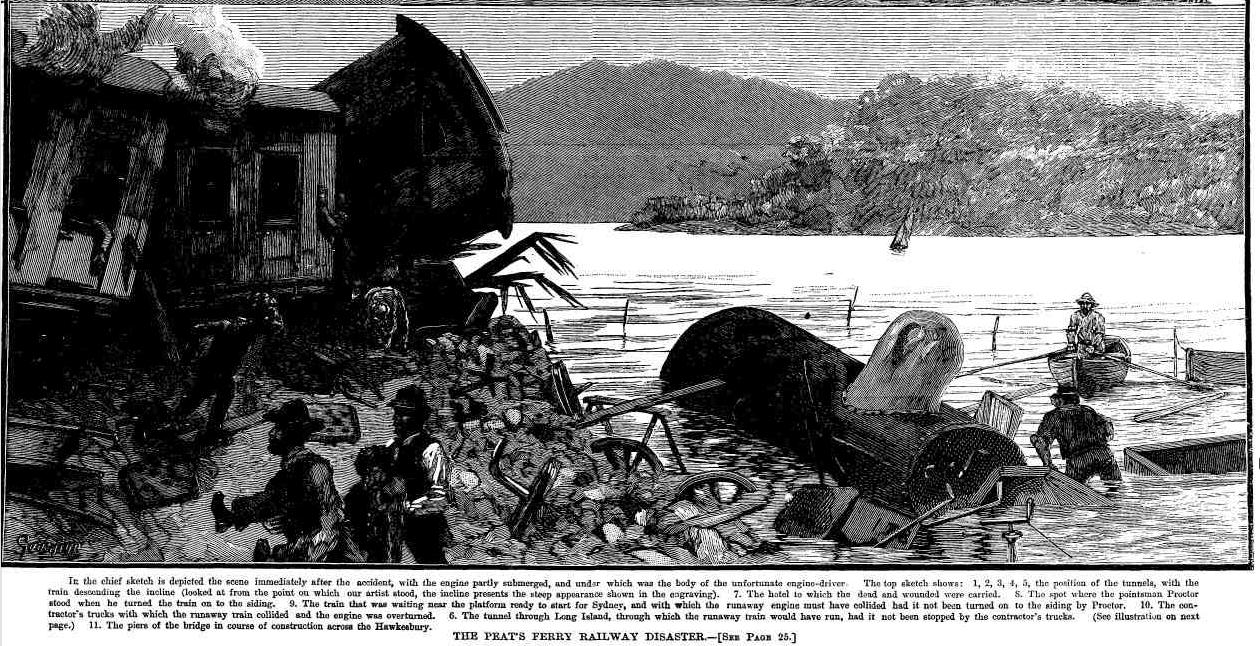
End of Long Island, facing North — showing; Tunnel opening out on the Hawkesbury through which the runaway train must have dashed, hard it nit In been checked by the collision with the contractor's trucks, and fallen into water a hundred feet deep or more. THE PEAT'S FERRY RAILWAY DISASTER.— [See Page 25.] The Railway Accident at Peat's Ferry. (1887, July 2). The Sydney Mail and New South Wales Advertiser (NSW : 1871 - 1912), p. 25. Retrieved from http://nla.gov.au/nla.news-article165222063
The Peat's Ferry Railway "Smash."
(See Illustrations on Pages 30 and 31.)
The terrible railway accident which, marred the Jubilee rejoicings in Sydney will be better understood from the illustration on page 30 than from any written descriptions. At the Ryde station, 12 miles from Sydney, the line is 83ft above the sea level ; and at Hornsby, 9 miles farther on, it is 592ft above the sea level. At Burrowa, 28 miles from Sydney, the height is 675ft ; and at the Hawkesbury, the scene of the accident, 35 miles from Sydney, the height is 6ft, or a descent of 669ft. in 7 miles. The grades in some cases are 1 in 40 ; and for the whole distance they are, very steep. The line, on leaving the high ridges, runs down to an embankment which stretches from the shore to Long Island, where the bridge begins ; and the level was not sufficiently long to neutralise the "way" on the train. In such circumstances any defect in the brakes, or any neglect to couple them properly, would be sufficient to account for the accident. No doubt some evidence will be adduced at the inquiry to show whether anyone was to blame for carelessness. This cannot undo the injuries already inflicted, or bring back the lost. But it may perhaps cause steps to be taken to prevent such occurrences in future.
On June 25 last William Rennie, who was killed in the railway accident, was buried in the cemetery, at Ryde; and among the mourners were his employers, the Messrs. Amos Bros., con-tractors. The same day the remains of William Henry Hankin were buried at the Enfield Cemetery; and the funeral was attended by a large number of (friends and about forty members of the Railway Ambulance Corps, of Which the de-ceased was a member. On the same day the City Coroner, the jury, and the witnesses in the coroner's inquiry visited the place, when the various gradients were described by Mr. Kirkaldie. On Monday last the inquest was resumed, when Mr. A. W. Nathan appeared for the late Mr. Rennie ; Mr. G. B. Simpson, Q.C., for the representatives of the Westinghouse, Brake Co., Mr. M'Carthy for Mrs. Wilson, Mr. T. M. Williamson for the fire-man Pye, Dr. Sly for the Commissioner for. Railways, and Mr. Rogers in the interests of the public. Mr. Francis Johnson, stationmaster, Redfern, gave evidence as to the construction of the train, time of starting, &c, and Dr. Clay as to the cause of death in the case of W. H. Hankin. Jacob Durham, shunter, and Andrew Wairick, examiner of air brakes, testified as to the construction of the Westinghouse brake, and the manner in which it was applied to the train. Alfred Clissold, guard of the train, said that the engine had stopped in ascending the incline between Ryde and Eastwood, and the train had had to be backed down. At Hornsby some more carriages were coupled on, and the train re-arranged. When they left Hornsby the important duty of testing the connection of air supply through the length of the train was omitted.
Miss Elizabeth Hunter, 22 years of age, residing at May-street, St. Peters, who was conveyed to the Sydney Hospital after the railway accident, suffering from fracture of the left leg and other injuries, died on Saturday. When admitted she was in such a condition from the shock that nothing could be done. The next day the leg was amputated at the thigh. But the operation following the shock to the nerves was too severe; and she gradually sank and died. She had gone out on a pleasure trip which terminated so disastrously.
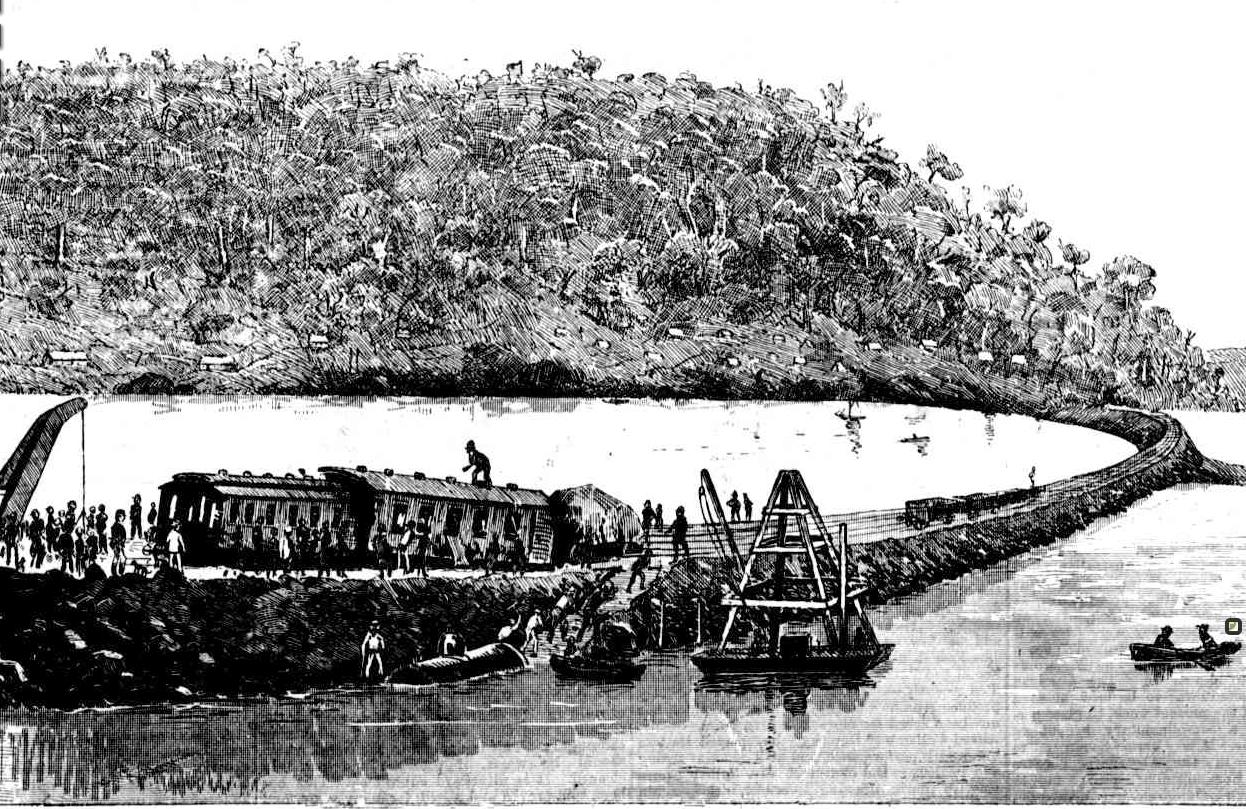
The recent Terrible Railway Accident at Peats Ferry, New South Wales – scene after the Disaster.
WILSON, THE ENGINE DRIVER.
Thomas Robert Wilson, the engine driver of the train which was wrecked, came of an old colonial family. His grandfather, Martin James Wilson, was born in Lancashire (England), and arrived in Sydney in 1816 with the 48th Regiment, of which he was color sergeant. He was appointed deputy gaoler of the old gaol in Essex street, where his son, William Wilson; father of the subject of the present notice, was born in 1827. Thomas Wilson was 38 years of age at the time of the accident which resulted in his death, and was born in Sydney, and educated in Turton School, Christ Church, Sydney. His first essay at work was made as a blacksmith's laborer in Russell's Foundry ; but, through the good offices of Mr. John Sutherland, he obtained an appointment as a cleaner on the railway, and by his steadiness and energy soon rose to the rank of fireman, and lastly junior driver, which position he held at the time of his death. He was known as a careful driver, and was expecting shortly to be raised to the superior grade.
He appeared to take a dislike to the new line from the first, and had a pre-sentiment that something would happen. Just before starting on his second trip he said to his elder brother, "I think that this will be my last trip on that line," and when leaving the house at 5 a.m., he remarked, "Don't be surprised if you hear anything about me. I think this will be my last trip on that line."
This was not because he apprehended any particular danger; but because, as he said, he would rather resign than run on the North Coast line. He was a general favorite with his fellow workmen, and with all who were acquainted with him. As an instance of his simplicity 'when a child, the following anecdote is told of him. There was at some time a wooden-legged man whom the children used to run after, and tease, and who may be called "Barney." One day little Tom Wilson saw a boy with a wooden leg going past; and he ran inside crying, "Oh, mother, come and look at old Barney's little boy," being evidently under the impression that wooden legs "ran in the family." Our portrait of Mr. Wilson is from an excellent photograph kindly supplied to us by Messrs. Channon and Co., of the Carrington Galleries, 631, George-street, Sydney.
On the afternoon of Friday, June 24, the remains of 'Thomas Robert Wilson were con-signed to their last resting-place in the Rookwood Cemetery.
The deceased had been a member of the Belmore Lodge of the Order of Druids, and, at one time an officer ; and the brethren of that order, together with a large number of his fellow employees, assembled at his widow's house. Edward street, Eveleigh, and followed his corpse to the grave. Behind the hearse came the mourning coach, containing the immediate relatives of the deceased, followed by a number of vehicles with those who had come to show respect to his memory. Preceding the hearse were the Druids in funeral regalia, and the fellow employees of the deceased to the number of some 400. The final rites of the Anglican Church were performed at the Necropolis and the remains were committed to earth by the Rev. R. A. White, of St. Barnabas's Church, assisted by the Rev. Mr. O'Connor, as curate. At the termination of the church service, the funeral oration of the Druids was delivered in an effective manner by Brother John Mitchell, secretary of the lodge to which the deceased belonged. The Rev. Mr. White then addressed the large throng around the grave, upon the subject of the deceased's, bravery upon the occasion of his death in sticking to his post; the address, concluding with an exhortation to those present to assist in some substantial acknowledgment to his widow and children, which he hoped would be considerably augmented by the Government, as doubtless it would; Sir Henry Parkes having in the House of Parliament alluded to the deceased and his connection with the disaster which terminated so fatally. The deceased's coffin, profusely strewn with flowers, was conveyed to the grave upon the shoulders of those who had worked with him in his last hours. The obsequies were under the management of Messrs. Wood and Co., of George-street south.
PROCTOR, THE POINTSMAN.
Proctor, the Peat's Perry pointsman, whose name has become almost a household word in this colony, and of whom a portrait is published in this issue, is a native of the Emerald Isle; and hails from the town of Trim, in County Meath. He was born in 1854, and is consequently in his 33rd year. He came out to this colony in August, 1881. Finding however, that there was little opening in Sydney for one of his trade, that of a cooper, he engaged in various employments until eventually about three years ago he entered the service of the New South Wales Railway Department. The part played by Proctor in the terrible disaster which marred the Jubilee celebrations was one of strict adherence to duty in circumstances of great personal peril, demanding great nerve and presence of mind. Owing to a train being drawn up on the main line at Peat's Ferry station, Proctor's orders were to turn the expected excursion train, into the siding ; and, with this object, he was standing by the points, when the shrill whistling of the engine, immediately followed by the appearance of the runaway train , dashing along the line at a terrific pace, made it evident that a calamity involving the most serious consequences was unavoidable. One of three results was inevitable - either the train would leave the rails at the points, and be precipitated down the railway embankment, killing the pointsman in its descent, or it would continue on the main line and collide with the train containing some two hundred excursionists standing in the station, or (and this third depended entirely on the coolness and pluck of the points-man) it would turn into the siding, and go speeding into, a number of empty trucks. Men who were standing near Proctor ran away ; and he himself warned a little boy who, was with him to run to a place of safety. How ever, he stuck to his post, and, exerting all his strength, put the points over, and sent the train into the siding. Had he for one moment faltered, or let go his hold, a dreadful catastrophe would have been the result, while the loss of life must have, exceeded that in any railway disaster which has ever occurred in the colonies. De-scribing his action in an official report to the Premier, which was read in the Legislative Assembly on the day following the disaster, the Commissioner for Railways wrote :
The pointsman, Proctor, realised the position at once, and with great presence of mind and intrepidity held the point firmly at great personal risk ; so that the runaway train was turned into the siding where it collided with trucks and was upset, instead of rushing as it would have done into another train, the resistance of which would have greatly increased the shock and smashed the whole train. To the pointsman's firmness in this moment of supreme danger, the escape of a large number of passengers is due.
In reading this Sir Henry Parkes gave expression to the opinion that, in all reasonable probability, Proctor, by his prompt and singularly clear action, had prevented the destruction of nearly the whole of the lives in the train; Sir Henry declared his intention of asking Parliament to substantially recognise Proctor's conduct.
A number of private individuals have taken the matter in hand; and already over £125 have been subscribed for the purpose of presenting Proctor with a testimonial.
HEROS OF THE RECENT PEAT'S FERRY RAILWAY DISASTER.
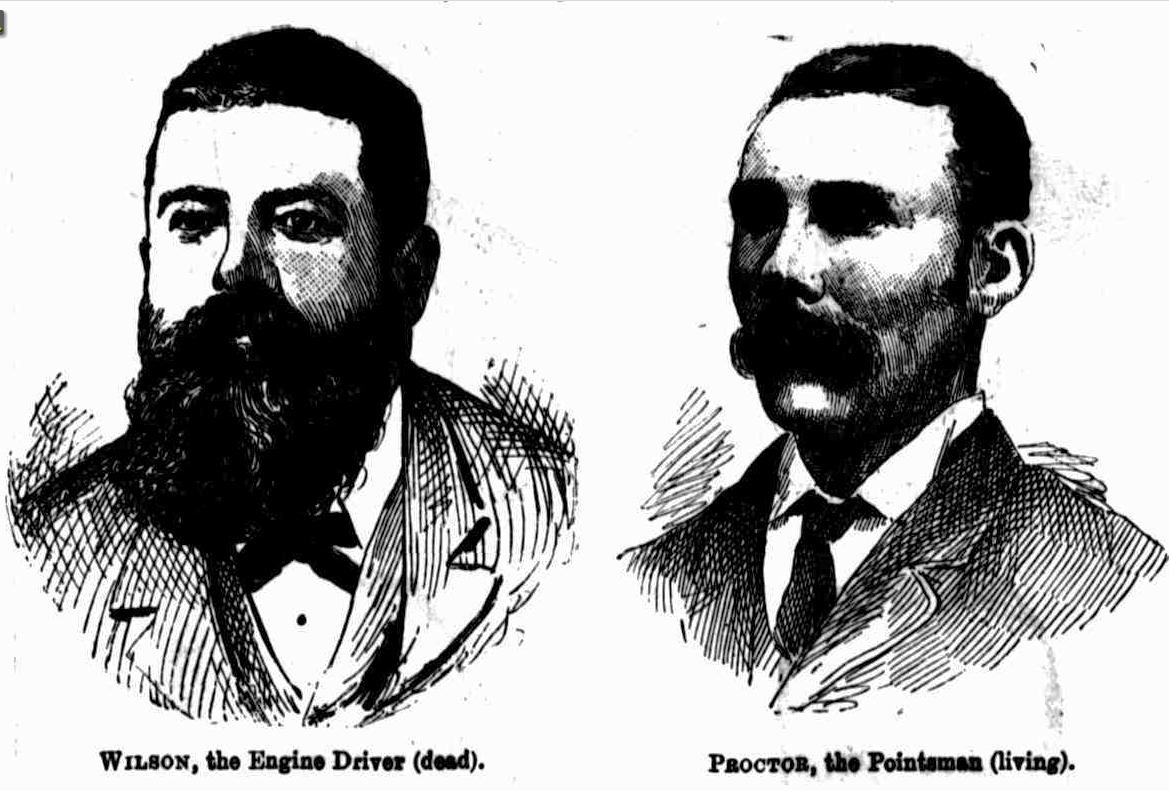
WILSON, the Engine Driver (dead). PROCTOR, the Pointsman (living).
The Peat's Ferry Railway "Smash." (1887, July 2). Australian Town and Country Journal (Sydney, NSW : 1870 - 1907), p. 31. Retrieved from http://nla.gov.au/nla.news-article71086668
THE RAILWAY ACCIDENT AT PEAT'S FERRY, HAWKESBURY RIVER. SAD RAILWAY ACCIDENT AT PEATS FERRY, HAWKESBURY RIVER.
HARDLY had the sympathetic reading public of the colony recovered from the severe mental shock caused by the rail-way disaster at Windsor, Victoria, when a nearer and more harrowing calamity of a similar character startles us out of our usual careless equanimity. Six slain, and forty or more injured, is assuredly a ghastly total to place to the contra account of the Jubilee rejoicings ; but such, unhappily, is the fact. One could hardly credit the rumour when, on the evening of the 21st ultimo, intelligence came to the metropolis that the 10.25 a.m. Hawkesbury train had sustained a terrible disaster. But, unhappily, with the arrival at No. 7 platform of a train containing the bruised and bandaged array of wounded, all doubt was removed, and the worst fears were found to be justified. The injured were carefully attended to, and particulars were eagerly invited from those who were not too weak or agitated to be perfectly helpless. The story was ascertained at length. The train, it seems, comprised, besides the engine, two Redfern carriages, two American cars, and five ordinary carriages. It left Redfern at twenty-nine minutes past ten with a full complement of passengers; in fact, as several affirm, with an overplus, considering the power of the engine. All seems to have progressed indifferently well, until a point near Beecroft was reached. The gradient was steep, and the train, after two efforts, failed to reach the height of the rise. The guard then divided the train into two parts ; first proceeding with one and then the other. At Hornsby, the parts were reconnected ; and, as there were no other ascending gradients, further difficulties were not apprehended. Four or five miles before reaching the Hawkesbury, a steep descending gradient is encountered; and, in traversing that, the disaster commenced. The driver seems to have lost all command of his engine ; the reliable Westinghouse brake suffered some sudden derangement, and the whole train rushed down the incline with an ever accelerating pace. Some of the passengers, noticing the increased speed and strange oscillation, fancied (like those recent Parisian theatre victims at the flaming and crackling of the fatal stage) that all this was part of the programme. Right in front stretched a train loaded with passengers, and a terrible telescoping seemed unavoidable.
At this juncture, whether by his own inspiration or not it matters little, a pointsman, Proctor, took in the situation with rapid glance, and, rushing to his points, he hung on with desperate tenacity. By this means the flying, oscillating train was diverted from the line of full carriages to one which contained but a few empty trucks. Into these the full mass dashed, and, amid indescribable horror, the accident culminated. The hiss of steam, the crash of splinters, and the cries of the wounded mingled in strange and piercing confusion. The engine had gone over the bank, carrying with it the driver, who had manfully stuck to his post like a true hero. Medical men and surgical appliances were speedily dispatched from Sydney to the scene of the disaster ; everything possible was done ; the wounded were relieved, and the dead reverently removed. Six had been killed outright, or had sustained injuries from which they have since succumbed. The injured are progressing fairly well, but the whole catastrophe has left a painful impression upon the public mind. The pointsman's pluck and swiftness of resource have received ample recognition ; and in the course of the exhaustive enquiry into the accident which the Railway department have initiated, it is to be hoped that facts will be elicited which may tend to minimise these terrible and unexpected calamities. Our artist has presented a general sketch of the melancholy scene of disaster.
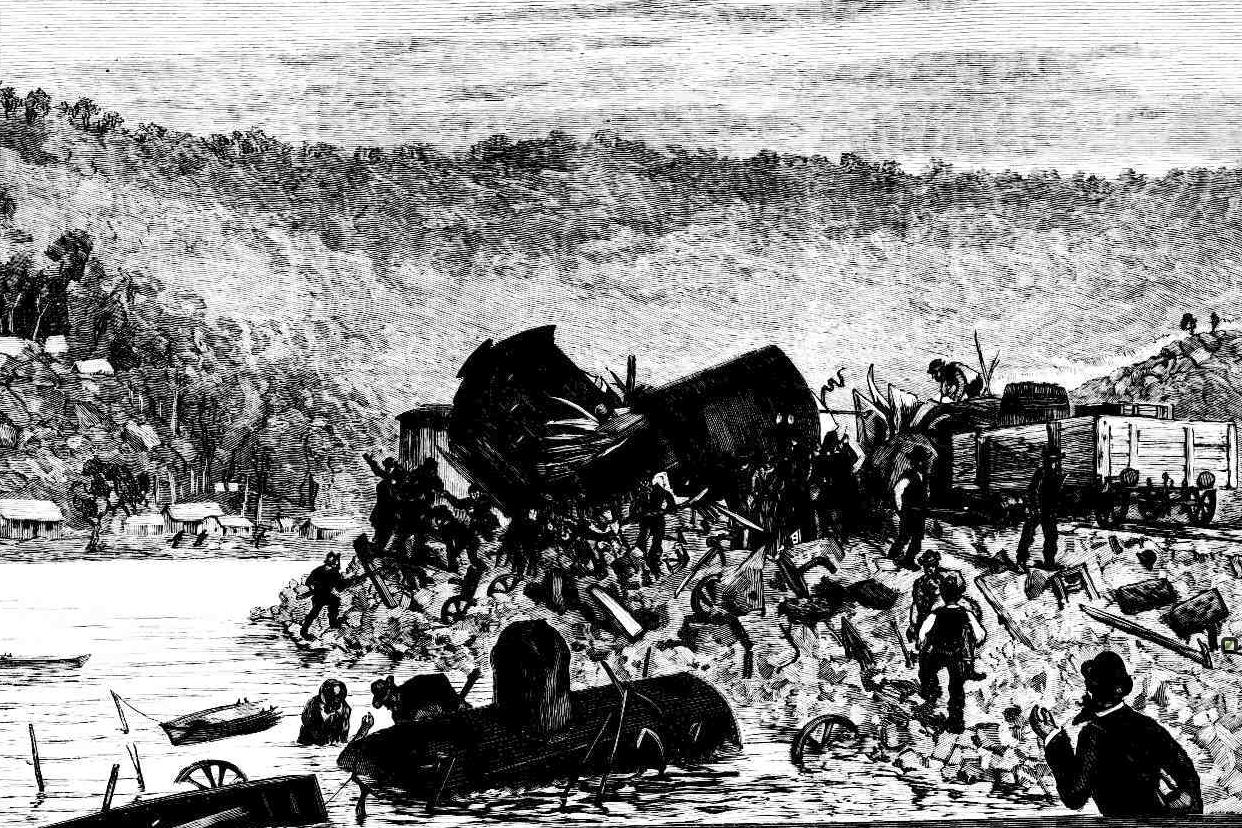
SAD RAILWAY ACCIDENT AT PEATS FERRY, HAWKESBURY RIVER. (1887, July 15). Illustrated Sydney News (NSW : 1881 - 1894), p. 8. Retrieved from http://nla.gov.au/nla.news-article63620688
Soon after that terrible accident::
THE HAWKESBURY RIVER BRIDGE STRIKE.
In connection with the labour dispute at the Hawkesbury River Railway Bridge, our Peat's Ferry correspondent wrote yesterday :—" On Saturday afternoon the s.s. Marra Marra brought five foreigners, "blacklegs," from Sydney for Messrs. Ryland and Morse, who despatched a launch, down the river to meet the vessel and to take the men to Dangar's Island. The contractors knew that had they allowed these "blacklegs" to come on to the wharf at Peat's Ferry, the strikers would have taken them all away. However, the strikers were not to be disappointed in this manner, for early this morning (Sunday) a gang of them proceeded to the island, and succeeded in persuading five "blacklegs," carpenters who had arrived by the steamer Promise from Gosford, and who were sent by Mr. Rock Davies, who is acting in conjunction with the contractors, to leave. They are now being kept in a boarding-house at the cost of the strikers until the dispute shall be settled. Yesterday (Saturday) being pay-day on the line, a large sum of money was subscribed by the navvies towards enabling them to hold out. There is no one in need, and the men are be-having in a very creditable manner. The latest information is to the effect that there are four constables on Dangar's Island at present. THE HAWKESBURY RIVER BRIDGE STRIKE. (1887, October 24). The Sydney Morning Herald (NSW : 1842 - 1954), , p. 9. Retrieved from http://nla.gov.au/nla.news-article13674467
The Strike at Peat's Ferry.
The strike for eight hours still continues. The strikers have now got circulars printed with the names, nationality, and occupation of all the 'blacklegs,' and are sending them to all the public works in the colonies. Dangar's Island is now like a military camp in time of war— congeneral order on the island is, ' All lights out at 10 p.m.' They keep a steamer in readiness under steam all night to pursue any boats 'that may approach. Three of the party ordered off the island on Sunday went again yesterday, and were ordered off immediately; but they walked round the island, the police after them, but they did not interfere with them. The Strike at Peat's Ferry. (1887, October 26). Evening News (Sydney, NSW : 1869 - 1931), , p. 4. Retrieved from http://nla.gov.au/nla.news-article108228565
Peat's Ferry Strike.
Peat's Ferry. — The last of the extra police sent to Dangar's Island, on account of the strike, left this morning. The island now is christened 'New Norfolk Island ' by the residents. The majority of the men employed by Messrs. Ryland and Morse, since the strike, are alleged to be fishermen from the Hawkesbury River. Some of the old hands have gone back. Peat's Ferry Strike. (1887, November 8).Evening News (Sydney, NSW : 1869 - 1931), , p. 6. Retrieved from http://nla.gov.au/nla.news-article108227490
THE EIGHT-HOUR DISPUTE AT HAWKESBURY.
FROM OUR SPECIAL REPORTER.)
PEAT'S FERRY. TUESDAY.
I arrived here at half-past 10 o'clock this morning from Sydney with a view to making inquiries into the alleged strike of a number of the workmen employed on the construction of the Hawkesbury bridge. On alighting from the train at Hawkesbury proper (termed by some " Peat's Ferry," by others "Flat Rock,*'and by others "Brook-lyn') the first thing that struck me was the unusually quiet appearance of the township, considering the fact that a large strike was said to be " on." I did not observe more than a dozen men about, of any kind, and from the lounging do-nothing air of these I was not long in coming to the conclusion that they were a portion of the strikers. I therefore made it my business to interview some of them, as well as certain of the storekeepers, and from them I learned that so far as one firm was concerned the strike was over, but that the dispute was still pending with the other. A third firm having a sub-contract has nothing to do with the trouble, having from the first adopted the eight-hour principle. Subsequently I interviewed the members of the firm who insist upon the ten-hour-principle, and it will be seen from their statement that they contradict a good deal of that stated by the men.
The construction of the Hawkesbury bridge is being carried on by three sub-contractors, under the supervision of a representative of the chief contractors, the Union Bridge Company of New York. These sub-contractors are the two American firms of Ryland and Morse, Anderson and Barr, and the New South Wales firm of Louis Samuel and Co. The contract of the last-named is for the building of the stone abutments of the bridge; the contract of Messrs. Anderson and Barr is for putting down the cylinders; and the contract of Messrs. Ryland and Morse is for the construction of the upper portion of the bridge. It is not necessary to say any-thing more about Messrs. Samuel, as they were never in the dispute, having from the commencement of their con-tract only required their men to work eight hours. Anderson and Barr arrived from America with their families and some half dozen head men or overseers about 12 months ago, and at the very start began with 10 hours work. Ryland and Morse, who arrived in last March from New York, also brought their families with them, and several employees, and started work about six months ago, also adopting the 10-hour principle. They employed about 60 men, and Anderson and Barr about 40. Com-plaint, however, was at once made about the long hours, and Ryland and Morse explained (this is the men's statement, be it understood) that unless they worked the 10 hours at the beginning they would be all behind with their contract: but to pacify them told them that as soon as things were a little more forward they too, like Samuel and Co., would not want the men to work more than eight hours. The men employed by the two firms had a number of meetings, and about a fortnight ago they made application to their respective employers to reduce the working hours by two. Both refused, and the men, acting in concert, then went out on strike. In this they had the sympathy of Samuel's men and of the large number of men employed by Messrs. Amos on the railways, who only work eight hours; and in this connection the men contended that it was a most anomalous condition of affairs, that while working on a railway bridge on what could only be considered a Government work for 10 hours a day, the whole of the men employed in the construction of the line only worked eight hours, and that the Government recognised the eight hours as a fair day's work. After standing out for 10 days, Anderson and Barr so far gave in to the men's demands as to concede the eight hours, but instead of giving 8s. a day reduced the rate of pay to 7s. 6d. with the understanding that the men should be paid a shilling an hour overtime. As a matter of fact many of them, I was assured, had since they had gone back (the middle of last week)-made as much as 9s. 6d. a day. Anderson and Barr are, it is alleged, behind with their work, and so had to accede to the men's demand, but with Ryland and Morse the case is exactly the opposite. They are well ahead and so can afford to wait, and are not pushed for workmen in the same way as the other American firm.
The strike was thus narrowed down to one out of the three firms at work on the bridge. Anderson and Barr have got down four of the cylinders out of the six ; it will take some time before the other two are down, and until they are Ryland and Morse will not have much to do, and so can afford to wait in the hope of the men giving in. Last Saturday was pay day, and practical sympathy was given to the strikers on all hands, as it is felt that their cause is a just one. (I am using the language of my in-formants.) It is alleged that Ryland and Morse have stated that they are unable to concede the eight hours, as they sent in their tender; believing that ten hours' work was the recognised thing in Australia ; but against this the strikers advance the argument that it was their business to have made inquiries, giving, an estimate as to the price of labour and the working hours in New South Wales; and that if reducing the working hours would be 10 per cent. out of their pockets as alleged, they have only themselves to blame. They feel that they are fighting for a principle, and that if Ryland and Morse are successful as extensive contractors, or sub-contractors of public works, in introducing the 10-hour wedge, there is no telling how far it may be driven in to the ranks of labour. Out of the amount earned by the men, a shilling a week deducted by the employers as an accident fund; but as there are a good many accidents at these works, the men do not complain of this. There are four or five cases now in the Sydney Hospital from the Hawkesbury bridge. The majority of the workmen have their families with them, and live in small huts usual at such works. Of course these men feel the shoe pinching a bit, but they are now getting, and hope will continue to get, the practical support as well as the sympathy of the workmen who are earning money. Messrs. Ryland and Morse's works are situated on Dangar Island, situate about half a mile from Peat's Ferry. Here they reside with their families and with the employees they brought out with them, and such men as are working for them and their families. They have been endeavouring to get labour from Sydney, but have been only partially successful. The steamer Marramarra has been bringing men up, but when she got alongside the wharf at Long Island the men on strike have gone on board and, almost without exception, have induced the non-unionists not to engage-or at all events not to go to work. But no violence of any kind has been used, and no threats-only fair argument. The consequence was that Ryland and Morse induced the captain to take his steamer on arrival from Sydney direct to the wharf at Dangar Island, so that the non-unionists could land without first being talked over by the " strikers." This, however, roused the indignation of the townspeople at the ferry, and they threatened to boycott the captain unless he brought his boat direct up to the wharf at Long island, which is connected with the township of Hawkesbury by the railway embankment-and this he accordingly did. I found, however, in the course of the afternoon that when this steamer arrived a steam launch went off from the works at Dangar Island, and took several men from her in mid river to the island direct, so that there was no fear of any interference with them by the strikers.
The men complained of foreigners being engaged by the 10-hour con-tractors, a batch of five coming up in one trip. These could not be persuaded not to go work on the island, as they did not understand the arguments used by the strikers. On Monday the man who is acting as secretary on behalf of the strikers went to Sydney, and had a handbill printed, and extensively circulated among the whole of the men at the bridge, giving the names of non-unionists working on the Hawkesbury River bridge, and the very worst class of non-union men. as they were the principal cause of the strike, and the first to start work at the 10 hours again. Out of 20 names given only two appear to be New South Welshmen, and they are natives of the Hawkesbury. The list comprises Scotch, English, " Yankees," Nova Scotians, Italians, " Americans," and Swedes, the men employed on the island have to work very hard from 7 in the morning to 6 in the evening, with an hour for dinner. There is no Saturday half-holiday, and not only do they work all Saturday but some of them have been working all Sunday as well, till they were stopped by the authorities. By the police ? Well, we suppose so ; but talking about police, we used only to have one here- now there are three or four on Dangar Island, and these are enough to incite the strikers to riot. We are all orderly men, and there have been no complaints of any kind, so we don't see why three police should be fetched down here to try and terrify us. Of course, when once they get these non-unionists on the island they are right. Continuing their story, I was informed that only about 16 men were now working on the island (all non-unionists, of course). Then followed a somewhat remarkable confession, as it appeared to me, to this affect : That the men would work the 10 hours if the masters would recognise the eight hours as a fair day's work; that they did not mind working 10 hours occasionally if they got a shilling an hour overtime. Then they complained bitterly of one of the Americans on the island who had been heard to say that "five shillings a day of ten hours was quite enough for the working men of this country."
The above is the version of the men. Having heard their side of the question, I proceeded across the half-mile or so of water in a small boat to Dangar Island. Here I introduced myself to Messrs. Ryland and Morse, whom I found in their office, and explained the object of my visit. "The strike ! " exclaimed Mr. Ryland, " well, some of the men knocked off work because they couldn't just have their own way. We happen to be the sub-contractors of this job, and we've got to do it in our own way. General Field was out in this country for six months making thorough examination of the location on behalf of his company-the Union Bridge Company of New York. That company, on his representations, tendered and got the contract. Subsequently my partner and I tendered for the upper work of the bridge, and here we are. We knew pretty well all about the working hours in this country, and we know that although eight hours is the generally adopted time in the city, it is not so in the country. We have built a good many bridges, and among them the celebrated Cantiliver bridge over the Niagara River, near the falls, and I fancy we know our work. Now, this is an American contract ; the work was planned in America, Americans have got the contract, and I reckon we are going to do it in our own way, and we are not going to give in. This is a free country, and if people don't like to work for us they can just stop away. Ten hours is our day's work, and there are various reasons why it should be so, for in a day of eight hours, with about three-quarters of on hour lost, there is not time to get through what we want done in a day. We always keep our engines going, and don't see the force of doing that for 16 hours at a stretch for nothing. But don't think we want our men to work for 10 hours for eight hours' pay.
No, sir';' we pay them by results, and the best man comes out at the top of the list. Here you see our pay-sheets. There are about 80 men there, and you may take the first 40 of them, and see they commence with us much as 17s. 6d. a day, gradually lessening till they get to 10s and 9s. Then the balance are labouring men -we give them 8s. a day all round; but the others are mechanics of various kinds, blacksmiths, carpenters, shipwrights, engine-drivers, strikers, and so forth ; but the labourer, who does mostly the shovelling of dirt and that, only gets 8s. a day. If a man ain't worth that, why, we won't have him. .We can get as many men as we want, who will gladly work the 10 hours and make good wages, and who object to be coerced. We have 40 men working here now for us. That's what it means. The men on the other side -have used all kinds of threats, and everything approaching to violence. They have thrown stones at the steamer when she has arrived alongside the wharf at Peat's Ferry, so we have had to bring the non-union men on here for their own protection. They have invaded our island and almost defied us. A party of 30 navvies came over in a couple of boats on Sunday, and landed on the shore between high and low water mark, and were most abusive. They were headed by the postmaster at Peat's Ferry (this was confirmed by the sub-inspector of police present), and I must say when Civil servants act in this way it is a matter of great surprise. What would be said if the police took sides in this way? This gentleman alongside you there is Mr. Sub-inspector Latimer. He arrived with three men on Saturday,-and although we did not send for them, there can be no doubt they are wanted for the protection of the people on this island, who have been most vilely threatened by these strikers. We have a total population here of 130 men, women, and children, and have just put up a schoolhouse, and are going to have a governess here, so that we are surely entitled to protection. This island is our private property-we lease it from Mr. Dangar-and all along the foreshores are notices warning persons not to land. But independent of that we have permission from the Government,-according to the terms of our contract, to make use of any public land that may be necessary for our purpose. We have no ill-feeling against the men who worked for us-not at all-and have no objection to employ them so long as they conform to our rules ; but as we are the masters and have to pay, and just know exactly what we want to do, and how it is to be done, we intend to have our own way. All we know about the strike we have seen in the Sydney press, and we can tell you it is nearly all news to us. ' The whole thing has been exaggerated, and facts by no means adhered to : but we tell you one thing sure, and that is in this job, which we want to make a big success, we mean to be the bosses, or we don't do it at all." And Mr. Ryland and his partner, Mr. Morse, said much more to the same effect-denying, among other things that they had ever promised to accede to the demand for eight hours, which it is not necessary to repeat. I have given both sides of the question ; the public can draw their own conclusions. THE EIGHT-HOUR DISPUTE AT HAWKESBURY. (1887, October 26). The Sydney Morning Herald (NSW : 1842 - 1954), , p. 12. Retrieved from http://nla.gov.au/nla.news-article13669017
THE HAWKESBURY RAILWAY BRIDGE.
At the invitation of the contractors for the Hawkesbury Railway Bridge, about 70 members of the Engineering Association of New South Wales visited Peat's Ferry on Saturday for the purpose of viewing the works now in progress at that place. The company journeyed from Redfern to the Hawkesbury in a saloon carriage attached to the ordinary train. Amongst those who availed themselves of the opportunity of viewing the progress of what is admitted to be a great engineering work were Mr. W. Cruickshank (president of the Engineering Association), Mr. G. A. Key (vice-president), Mr. G. Sands (hon. treasurer), Mr. Gustavo Fischer (hon, secretary), Mr. W. E. H. Nicollo (secretary), Colonel E. C. Cracknell (superintendent of telegraphs), Professor W. H. Warren, M.I.C.E., Major Parrott, Mr. W. Scott (locomotive engineer), Messrs. G. A. Morell, J. Richmond, A. D. Nelson, W. Shellshear, Trevor Jones, Norman Selfe, Wilson, Owen Blackett, L. Hargrave, and W. T. Poole.
At Long Island the visitors were met by Mr. Oscar Schulze, engineer for the Union Bridge Company of New York (who were the successful tenderers for the construction of the Hawkesbury railway bridge), Messrs. Ryland and Morse (contractors for the superstructure), and Mr. Anderson (of Anderson and Barr, contractors for the sub-structure).

Edwin Morse,the American bridge engineer and his wife Elizabeth sitting in front of their cottage on the island in 1887 koala in background
Later in the day Mr. McDonald, a partner in the Union Bridge Company, joined the visitors. The steamer Squirrel was lying "at the wharf in readiness to convey the party to the several places of interest, and after a short delay a complete tour of inspection of the whole of the works was made by the engineers, who expressed themselves as being highly pleased with what they saw on every hand. An inspection of some of the caissons proved very interesting. Dredging was being carried on by means of " grabs," which were constantly bringing up large quantities of stuff from the river bed at the bottom of the tubes. The winding machinery, the apparatus for measuring and mixing the concrete with which the inside of the iron casing is filled, and other appliances were also shown to the visitors.
Each of the piers for the bridge-six in number-will consist of a wrought-iron caisson, with three central tubes which assume a conical shape towards the bottom, thus forming a cutting edge. The caisson is sunk by excavating through the tubes. When complete, or sunk into proper position, the caisson and tubes are filled with concrete, and ashlar masonry is continued from low-water mark to the under side of the girders, which rest upon the stonework. The structure itself will be what is known as a lattice-girder bridge, of American design. The top boom is to be of trough form, with horizontal and vertical plates and angle irons. The bottom boom, or chord, will consist of a number of eyebars, threaded together on steel pins. The vertical, or compression members, will consist of wrought-iron columns, formed with plates, angle irons, and latticed com-pound bracing. The tension members will consist of eye-bars, somewhat similar to the bottom chord. There will be seven spans, each measuring 416ft. from centre to centre ; total depth of girders, 60ft. ; height of girders above high-water mark, 45ft. in the clear.
Mr A C Brayne (Government inspector of works) supplied our representative with the following figures having special reference to the construction and progress of the several caissons - No 1 caisson was commenced August 4th, 1887, and finished on the 23rd of last November, it has been sunk to a depth of 50ft in the bed of the Hawkesbury, and 3062 yards of concrete were used in filling it; total weight of caisson rather more than 213 tons. No 2 caisson is in course of construction, about 240 tons of iron having been used up to date. The third caisson is also in course of construction, 278 tons of iron having been used so far as the work has gone No 4 was commenced on the 23rd February, 1887, and completed to receive masonry on the 27th of last July. This caisson has gone down to a depth of 120ft in the river bed. It weighs more than 287 tons, and 4628 yards of concrete were used to fill it in. No 5 was the first caisson put in position It was located on the 9th December, 1886 Some difficulty has occurred in connection with this particular caisson, and the work has had to be abandoned for a time in order to get on with the other piers. It is said to be about 4ft out of position at the present time, but the contractors state that this will not cause any delay.
When Nos 1, 2, 3, and 4 piers are completed this caisson (No 6) will be attended to, and it will probably be brought into line, or failing this, doubtless another will be put down in its place. It is said that 295 tons of ironwork and 3000 yards of concrete have been used in the construction of No 5. No 6 caisson was commenced on May 6, 1887, located on the 18th of the same month, and is at the present time sunk 70ft in the bed of the river, but work in connection with this pier has been suspended until the contractors can go back to No 6. It was originally intended to start building the bridge from the Gosford side of the river, but in consequence of the difficulties experienced in sinking No 6 caisson the idea has been given up, and the work is now being pushed on with vigour from the Sydney side of the stream, at which end the abutment and No 1 pier are almost ready to receive one of the spans. In a month's time the second pier will be sufficiently forward to enable the men to commence the stonework.
Two of the caissons, Nos 1 and 4, are completed, but the masonry is not quite finished. The contractors are well satisfied with tho progress that has been made in putting down the others. No. 1 pier is the only one resting upon the solid rock. The other five rest upon sand so hard that it cannot be dredged, but this very hard sand forms a good foundation. Some idea of the nature of the work that has to be done in order to put down the piers may be gained when it is stated that it is necessary to go to a depth of 165ft below low-water mark in order to sink the last caisson (No 6) on the Gosford side of the river The depth of the foundations for the other piers varies from 100ft to 150ft below low tide. The following figures show the depth of water at the several piers at low tide -No 1 pier, 37ft 6in , No 2, 40ft, No 3, 40ft , No 4, 20ft , No 5, 18ft 6in No 6, 46ft. 6in. The contractors for the various portions of the bridge expect to have their work completed within the time stipulated in the agreement, viz , about nine months from the present date. The contract for the abutments, &c , was secured by the late Mr L Samuel.
Subsequently the members of the association were taken across to Dangar Island, in order that they might have an opportunity of seeing the various portions of the bridgework brought from Glasgow by the ship Deveron, which was lying close inshore, and the huge punt, which has been specially constructed for the purpose of erecting the superstructure of the bridge. This punt is 330ft. long, 60ft. wide, and 10ft deep. It is built in 48 watertight compartments, so that it is next to impossible for it to receive any serious injury. A gigantic trestle more than 40ft high, has been firmly built upon the punt and upon this trestle each span required for the bridge will be constructed. When the span is completed, the punt will be towed up the river to a portion between the pier intended to receive it. This operation will take place at high water, and as the tide flows back again into the Pacific the span will slowly settle down into its proper position on the piers. When the whole of the spans are erected the bridge will be ready for use. The building of the first of these spans will probably be commenced in a fortnight's time. The various portions of the bridgework examined were found to be about the best of its kind pro-curable. Everything is constructed of steel, and the Glasgow makers have turned their work out of hand in a splendid manner. The tensional eyebars were greatly ad-mired. These were made in America, from material manufactured in Scotland, it being found more economical to take the steel from Scotland to the States and have the eyebars made there, for the simple reason that the American manufacturers have made a specialty of this class of work, and have erected special machinery in order to turn it out of hand. There are about 200 men employed on the works at the present time. About 100 families live on Dangar Island, and here the contractors have their offices. Although the bridge is being constructed by American engineers, there is only one Yankee employed upon the works other than the contractors themselves " the rest of the crowd"-as Mr. Ryland put it-being Australians
At midday the visitors were entertained at luncheon by the contractors. The tables were laid on a large punt or barge, and as the weather was intensely close and trying, this craft was towed out into midstream and kept on the move, which had the effect of making things more agreeable. And ample justice having been done to the viands,
Mr CRUICKSHANK, who occupied the chair, proposed " Success to the Contractors for the Hawkesbury Bridge " He was sure every member of the association had enjoyed the outing, and it they had put themselves to any inconvenience in attending, he thought they had been amply repaid by what they had seen (Hear, hear ). The construction of the Hawkesbury bridge was a novelty in many ways, and it was evident that we in this country have not yet arrived at the stage of development when we could do the work ourselves. But still we were progressing in a certain ratio. We knew that the Americans were far ahead of us in many ways, but the people of New South Wales hoped to catch them some day. (Hear, hear.) They could not but admire the fact that the contractors for the bridge had entered into the open market and successfully tendered for the work. The bridge was the best that could be designed for a place like the Hawkesbury. (Hear, hear ) He asked them to drink success and prosperity to the contractors in carrying out their work. (Applause )
The toast was drunk with enthusiasm.
Messrs. Anderson, Ryland, and Morse replied in suitable terms, and expressed the pleasure it had afforded them to have the members of the Engineering -Association with them that day
Other toasts followed, after which the party were photographed, and then left for Sydney, arriving in town at 6 p m.
On the homeward journey the PRESIDENT (Mr. Cruickshank) announced that the engineers and those belonging to kindred institutions in the other colonies who may be in Sydney during the centennial festivities would be taken for on excursion on the harbour on the 27th instant. It was also intended to visit the Colonial Sugar Company's Works, and possibly Morts Dock, Cockatoo Island, and the Atlas Works. THE HAWKESBURY RAILWAY BRIDGE. (1888, January 16). The Sydney Morning Herald (NSW : 1842 - 1954), , p. 8. Retrieved from http://nla.gov.au/nla.news-article13677246

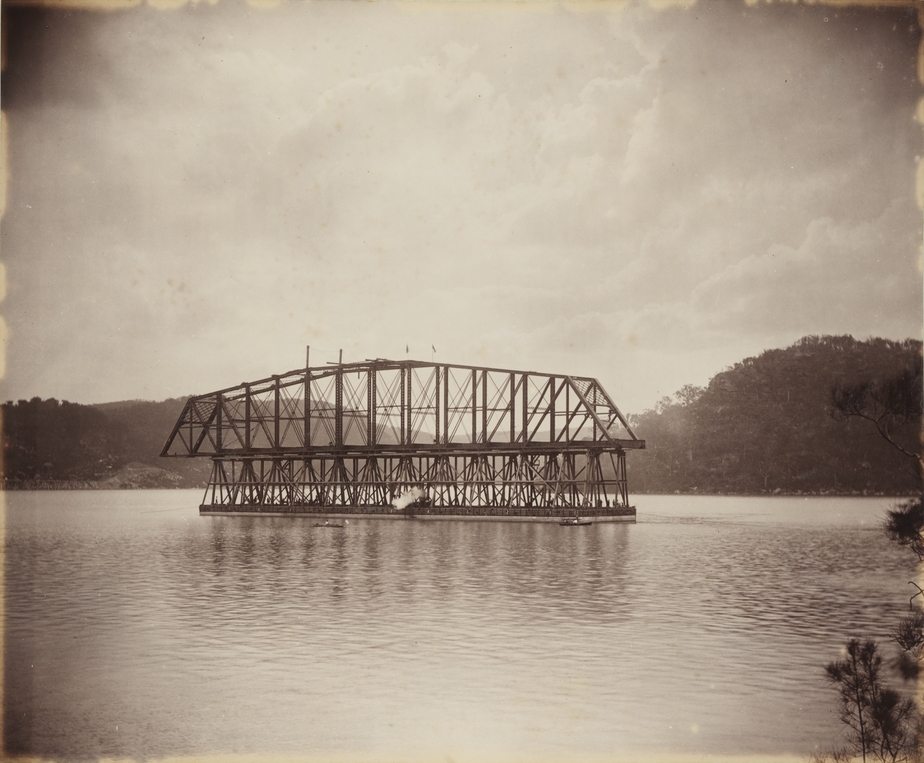
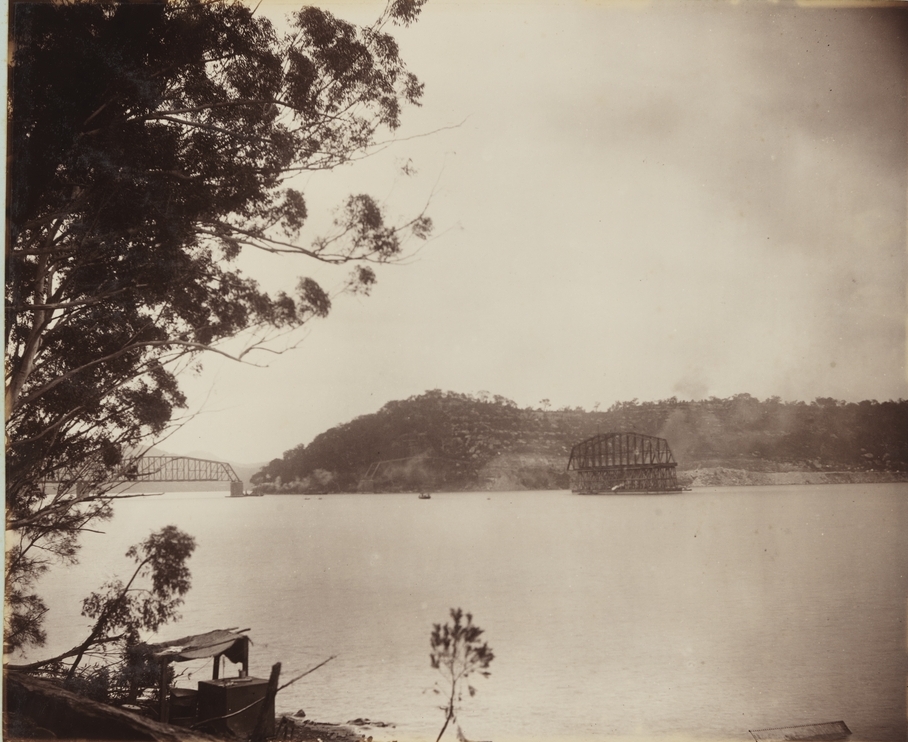
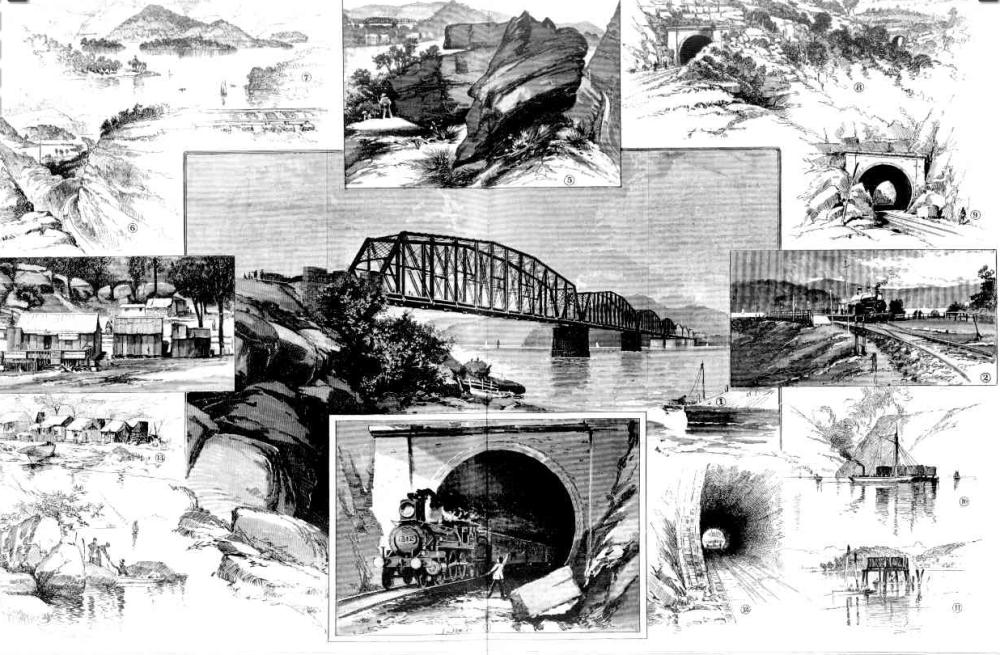
The Hawkesbury Railway Bridge.
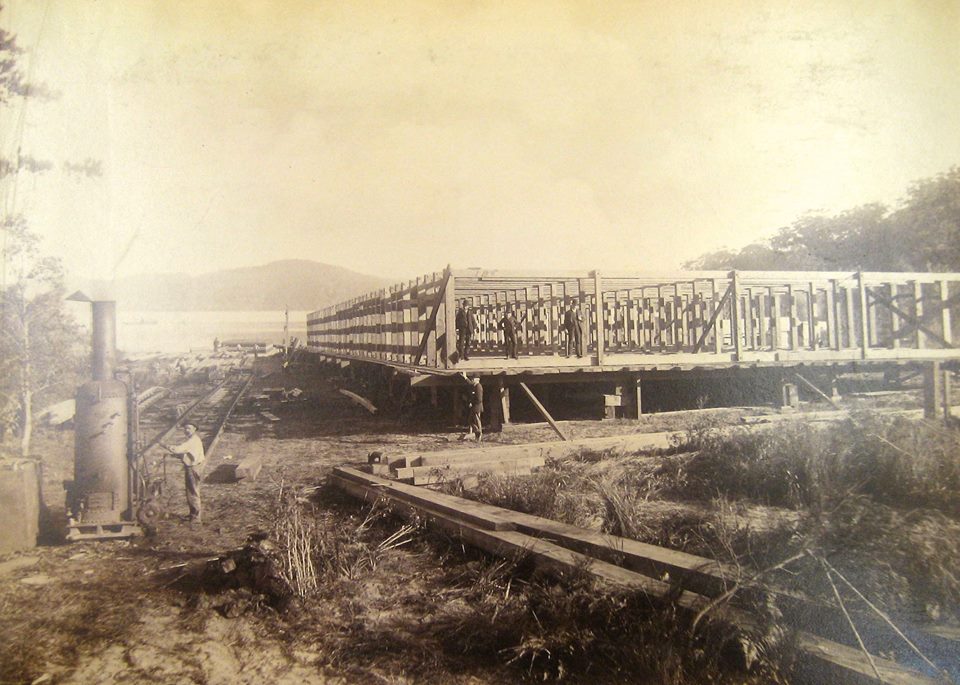
Opening of the Hawkesbury Bridge.
(FROM OUR REPORTER.)
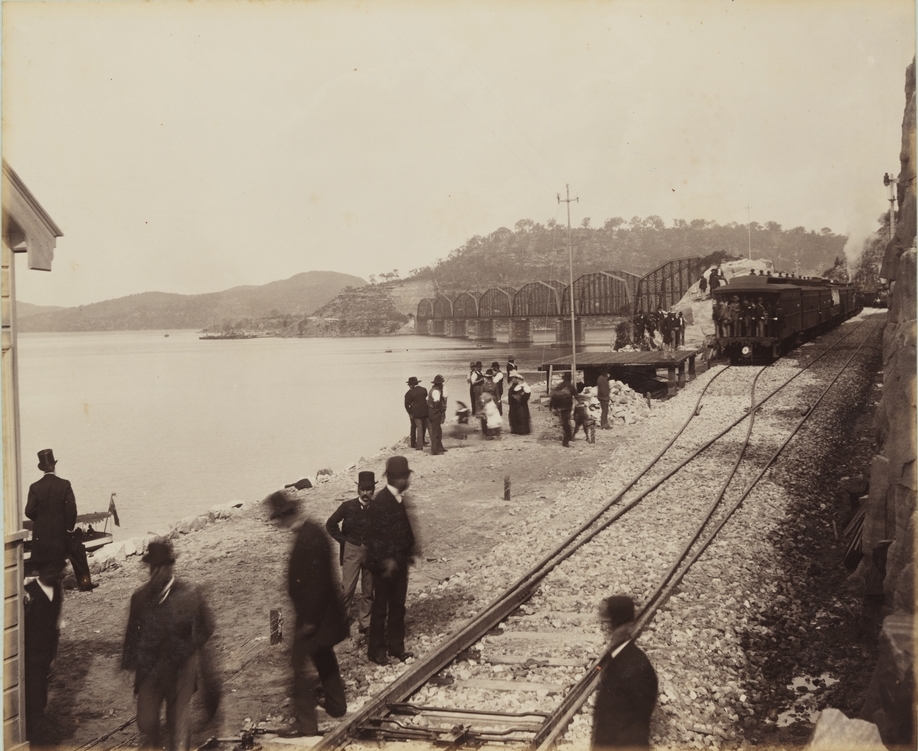
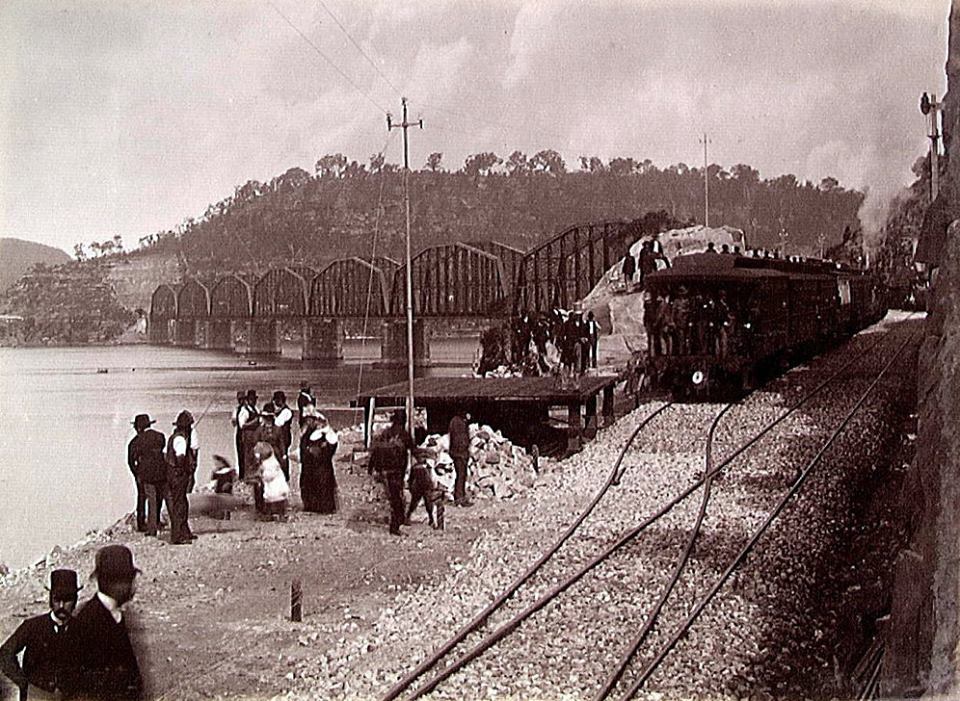
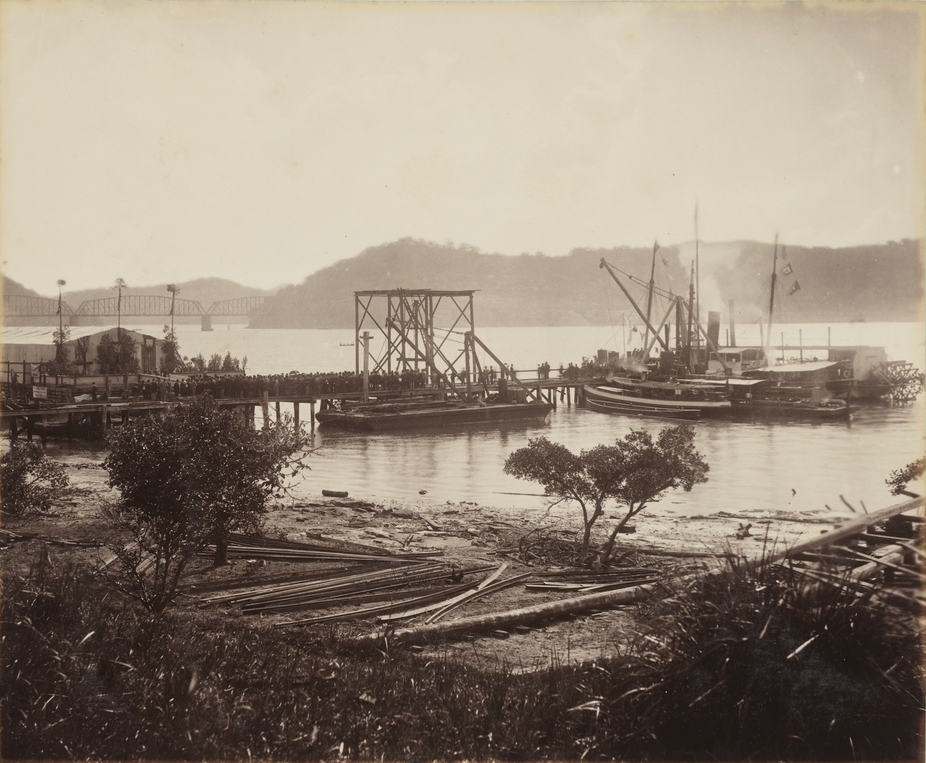
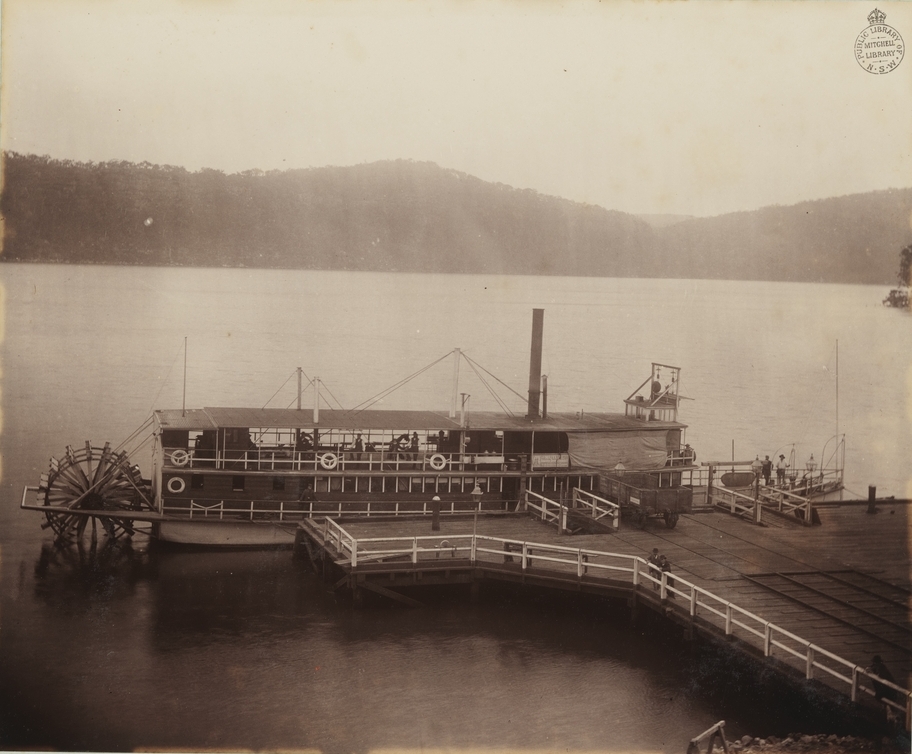
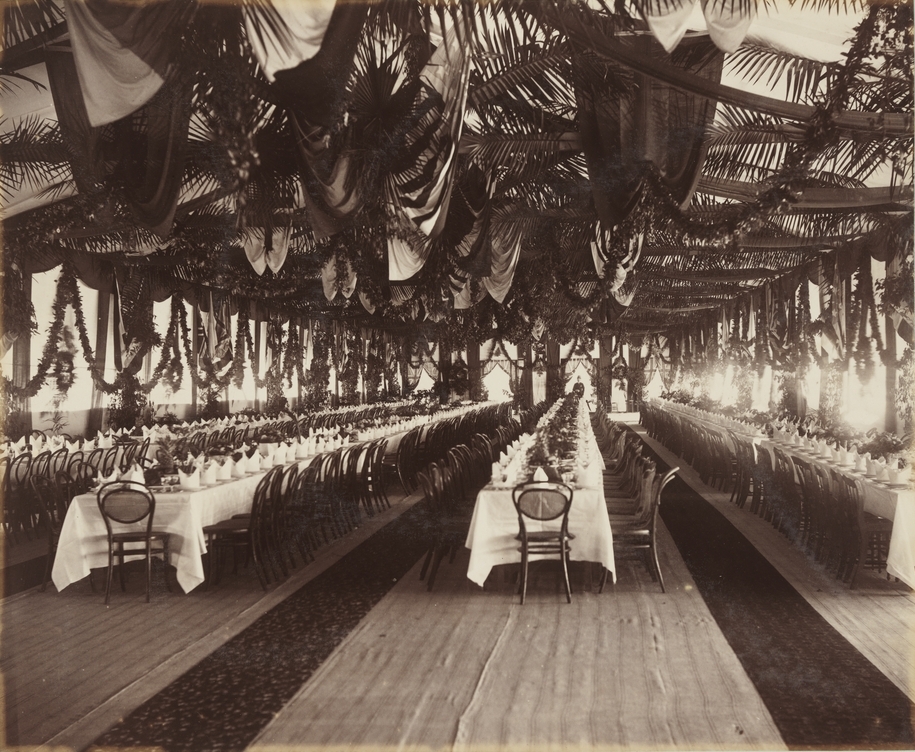
OPENING OF THE HAWKES-BURY BRIDGE.
THE DEMONSTRATION.
SPEECHES BY LORD CARRINGTON, SIR HENRY PARKES, AND MR. EDDY.
 The bridge over the Hawkesbury River, one of the largest structure of its kind in the southern hemisphere, and as regards its foundations one of the most remarkable in the world, was opened yesterday by his Excellency the Governor amid festive rejoicing.
The bridge over the Hawkesbury River, one of the largest structure of its kind in the southern hemisphere, and as regards its foundations one of the most remarkable in the world, was opened yesterday by his Excellency the Governor amid festive rejoicing.
Two special trains left Sydney at half-past 10 o'clock conveying nearly 700 people to the Hawkesbury to take part in the celebration. The weather was charming— a finer specimen of an autumn day could not be desired— and Hawkesbury scenery could not be seen to greater advantage. The stations along the route were decorated with flags and flowers and shrubs, and at Brooklyn there was a grand display of palms and blooms and foliage plants. A train from Newcastle, conveying about 100 visitors, arrived at the same time as the two specials from Sydney, and all were taken over the structure.
In the presence of a goodly gathering Lord Carrington formally declared the bridge open. The ceremony, which was of the briefest possible character, took place on a platform erected on the northern side of the bridge. Upon the platform were Sir Henry Parkes, the Colonial Treasurer, the Minister of Justice, the Minister for Mines, the Postmaster-General, the Rail-way Commissioners (Messrs. Eddy and Oliver), the Hon. Rupert Carington, and a number of other gentlemen. After the bridge had been declared open cheers were given for the Queen and for Lord Carring-ton. Three steamers were in attendance on the river— the Thetis, the Ajax, and the General Gordon— for the purpose of enabling the guests to view the scenery. The vessels were soon crowded with passengers, who found abundant opportunities for admiring the striking and characteristic scenery.
Time was pressing, and the trip down the river was necessarily short. A return was made to the neighbourhood of the bridge about 2 o'clock, and the company assembled on the large pontoon for luncheon, the principal item in the day's programme. After the repast the special trains started for Sydney and Newcastle, the metropolis being reached shortly after 7 o'clock. The Railway Commissioners (Mr. Eddy and Mr. Oliver), the prin-cipal under-secretary (Mr. Walker), and the traffic manager (Mr. Kirkcaldy) were most attentive to the guests. The arrangements for the comfort of the visitors were upon the whole satisfactory, but the Government and the Railway Department were evidently not quite prepared to receive such a very large assemblage, and consequently upon the trains, the steamers, and the pontoon there was a good deal of crashing and scrambling for positions. The Vernon band was in attendance, and played selections during the day.
By the opening of the bridge the last link has been completed in railway communication between Adelaide, Melbourne, Sydney, and Brisbane. On Monday, January 16, 1888, the capitals of New South Wales and Queensland ware connected. The two extensions which were required to complete the intercolonial line were then just finished, and without any formality the communication was established on the date given above. The last section of the Great Trunk Line commenced at Tenterfield, 381 miles from Newcastle, and terminated at the Queensland border, 392 miles 41 chains 96 links, being a total length ef 10 miles 70 chains 69 links. The height of the rails at Tenterfield is 2829 feet above high water spring tides at Newcastle, and at the Queensland border it is 2974ft., or 145ft. higher than at Tenterfield, the lowest point being at 337 miles 31 chains, or about the centre of this extension, where it is 130ft. below Tenterfield, and 275ft below the border junction. Messrs. George Stephens and Co. were the contractors for the general works upon this ex-tension. At Wallangarra, the border station where the different gauges of the Now South Wales and Queensland railways, 4ft. 8½in. and 3ft. 6in. respectively, are in vogue, in addition to the accommodation already given by the Queensland, authorities, the Government of New South Wales has provided a goods-shed and loading platforms, together with Customs offices for both colonies, and also sheep and cattle races, yards, and siding. The line to these trucking yards is common to both gauges by the interposition of an additional rail within the broader gauge of the two.
The section between Hornsby and Hawkesbury, of 15 miles, was opened on the 7th of April, 1887, and the longer section, that between Gosford and Waratah of 50 miles was opened on the 15th of August of the same year. On the 16th of January that portion between Mullet Creek and Gosford— a distance of 10 miles— was thrown open for traffic. OPENING OF THE HAWKESBURY BRIDGE. (1889, May 2). The Sydney Morning Herald (NSW : 1842 - 1954), p. 7. Retrieved from http://nla.gov.au/nla.news-article13744427
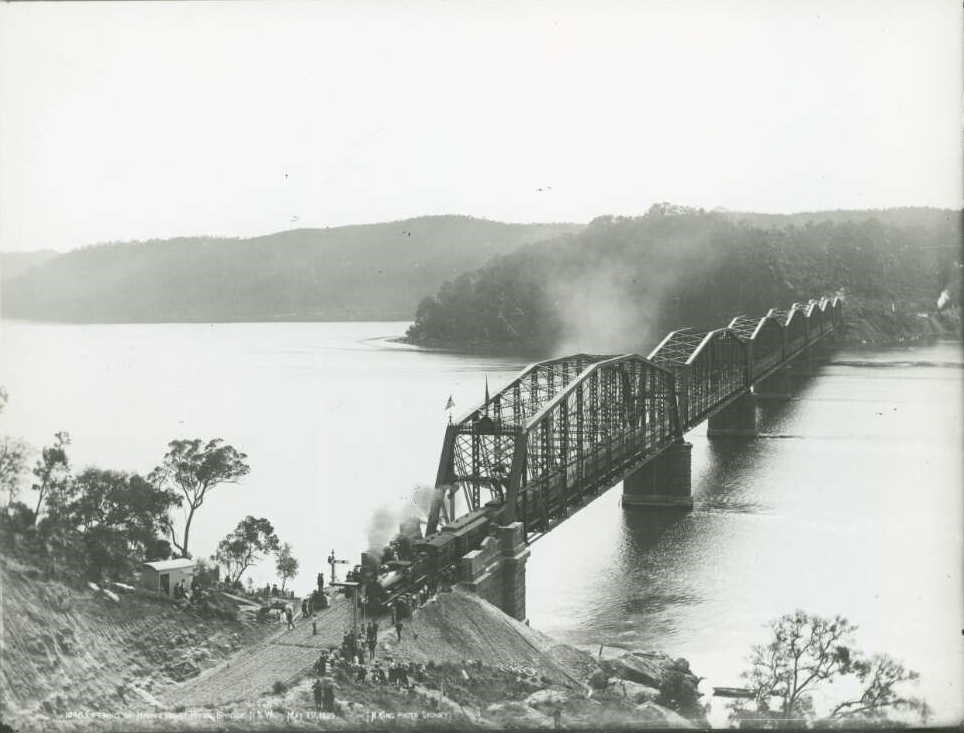
Official opening of the Hawkesbury River Railway Bridge, New South Wales, 1 May 1889 [picture] Henry King. Retrieved from http://nla.gov.au/nla.obj-155020979 - courtesy National Library of Australia
The first bridge was only in use for 57 years all up, while the current one is almost 72 years old. The ride aboard a train is worth taking for the scenic value alone as the track wends through beautiful country you won't see from the road - and then you get to cross that bridge - and be part of an Australian icon and history - or something so wonderful it's spoken of, written about and painted by generation after generation.
You can still catch a ferry up the Hawkesbury from Palm Beach - you can still catch a train over that bridge - well worth considering during these glorious blue mid-Winter days - or even something for youngsters who will soon be on school holidays. After so many images showing us so much - one that emerges from an Artist - a Pittwater Artist - of course!:
'HAWKESBURY WATERS'
The beautiful picture, 'Hawkesbury Waters,' by Robert Johnson, which the 'Mail' published as a Christmas supplement, was naturally best appreciated by people who know' that glorious river well. Among them is Mr. W. F. Jaques, of Mosman, and he supplies the following 'key.' His description was written for friends in America, but it will also interest many Australians.
IN the far distance, a little to the right, a glimpse is given of the horizon of the Pacific Ocean with the cliff face of the North Head of Broken Bay. The South Head of the bay with the Barrenjoey Lighthouse is hidden by the high land to the right. Between these heads the Hawkes-bury Waters join the Pacific. Just to the left of and inside North Head can be distinguished the form of Lion Island, with the bluff head of the lion couchant facing the Pacific. Between Lion Island and the land beyond is a wide stretch of deep water, which is hidden by the body of the Hon. On the extreme right of the picture in the mid-distance is Refuge Bay, a favourite camping ground for yachtsmen and launch parties, where a perennial rill of pure, clear, fresh water supplies their wants in that respect.
THE centre of the picture represents part of the tidal estuary, which is known as Hawkesbury Waters. It is the central or main branch of a very extensive and beautiful waterway, ideal for boating. The northern branch extends some miles to Woy Woy Creek and Broadwater, on the western, shore of which is the town of Gosford, on the Main Northern railway line, 50 miles south from Newcastle to the north of it, and 50 miles north of Sydney by the very tortuous railway track along the high ridges overlooking the waterway. The central branch here shown extends to the left for some miles west, past the great railway bridge, which crosses it with its seven steel spans, each 410 feet. Connecting with this central branch are other beautiful deep waterways extending for many miles, such as Cowan Creek, on the south, with its many minor branches, deep water everywhere up to 10 fathoms, and its steep and rocky sides, a veritable canyon with deep water floor. On a bright, calm day, skimming along the surface in a launch, with the clear, transparent water below and the precipitous rocks and hills up to 700 feet on either side, and sky above reflected below, is like floating in mid-air along a deep bottomless canyon, with sky above and sky below. Along the northern ridges winds the railway line. Another minor branch on the south side is Berowra Creek, also beautiful. On the northern side of the central branch is Mullet Creek, along the western edge of which winds the Northern railway from the great Hawkesbury Bridge to the tunnel, about half a mile in length, connecting with Woy Woy Creek, a popular resort and fishing ground, and so connecting with Broadwater on the northern branch.
THE third main branch of this wonderful triple waterway is called Pittwater. It extends for many miles south from Barrenjoey Lighthouse on the South Head of Broken Bay, towards Manly, to Newport, forming on its east side a long peninsula between it and the Pacific, while on the west side for six miles it is the eastern boundary of Kuringai Chase, a national park of over 35,000 acres, extending west to Cowan Creek. In Pittwater alone a great navy could be safely anchored. Into the central Hawkesbury Waters on the west flow the Grose and Nepean rivers, whose watershed drains the Blue Mountains. Along the eastern edge of the present high land a break and fault occur in the strata where the eastern portion of the plateau at some remote period gradually sank, the most eastern portion below the sea along the coast, and intermediately allowing the sea to flow back into the gullies and canyons which now form the Hawkesbury and Sydney Harbour waters. "HAWKESBURY WATERS" (1935, January 16). Sydney Mail (NSW : 1912 - 1938), p. 46. Retrieved from http://nla.gov.au/nla.news-article166110565
1. Hawkesbury River Rail Bridge and Long Island Group. NSW Office of Environment & Heritage. Retrieved from: http://www.environment.nsw.gov.au/heritageapp/ViewHeritageItemDetails.aspx?ID=4800130

Navigation Restriction - Hawkesbury River Railway Bridge, Hawkesbury River - Span 2 closure bridge maintenance works
(Marine Safety Act 1998 s.12)
Hawkesbury River Railway Bridge, Hawkesbury RiverSpans 1, 2 and 3 closure - Bridge maintenance works
Monday 9 April 2018 to Friday 20 July 2018
THE WORKS
Vessel operators are advised that due to maintenance works on pier three and pier four of the rail bridge across the Hawkesbury River (south of Cogra Point), navigation through spans 1, 2 and 3 will be restricted, from Monday 9 April to Friday 20 July 2018.
Due to the potential to affect the safety of navigation, an exclusion zone will be established on the navigable waters of the Hawkesbury River, which will extend approximately 50 metres upstream and downstream of the Hawkesbury River Railway Bridge. The exclusion zone will be marked by lit yellow buoys and signage.
Unauthorised vessels are prohibited from operating within the exclusion zone.
NAVIGATION WARNING
Vessel operators are advised to exercise extreme caution when navigating in the vicinity of the works and to pay particular attention to work vessels and buoyed off areas. This navigation warning remains in place for the duration of the works.
DIRECTIONS
Roads and Maritime advises:
a. Vessels are required to maintain a safe distance and speed from the works and operators are reminded that the production of wash which impacts unreasonably on the works is an offence (Marine Safety Regulation 2016 – clause 11(2) - Maximum Penalty $5,500.00)
b. Persons within the vicinity of the works must comply with any directions given by a Boating Safety Officer or Police Officer in relation to the works or to marine safety. Failure to comply with any such direction is an offence (Marine Safety Act 1998, s.15A - Maximum Penalty $3,300.00).
MAPS & CHARTS AFFECTED
Roads & Maritime Services Boating Map – 9B
For further information concerning this Navigation Restriction, please contact the Roads and Maritime info line on 13 12 36 or Sydney Trains Customer Service 131 500. MARINE NOTICE SY1813
The Peats Ferry Bridge (1946)
Carl Oscar Schulze
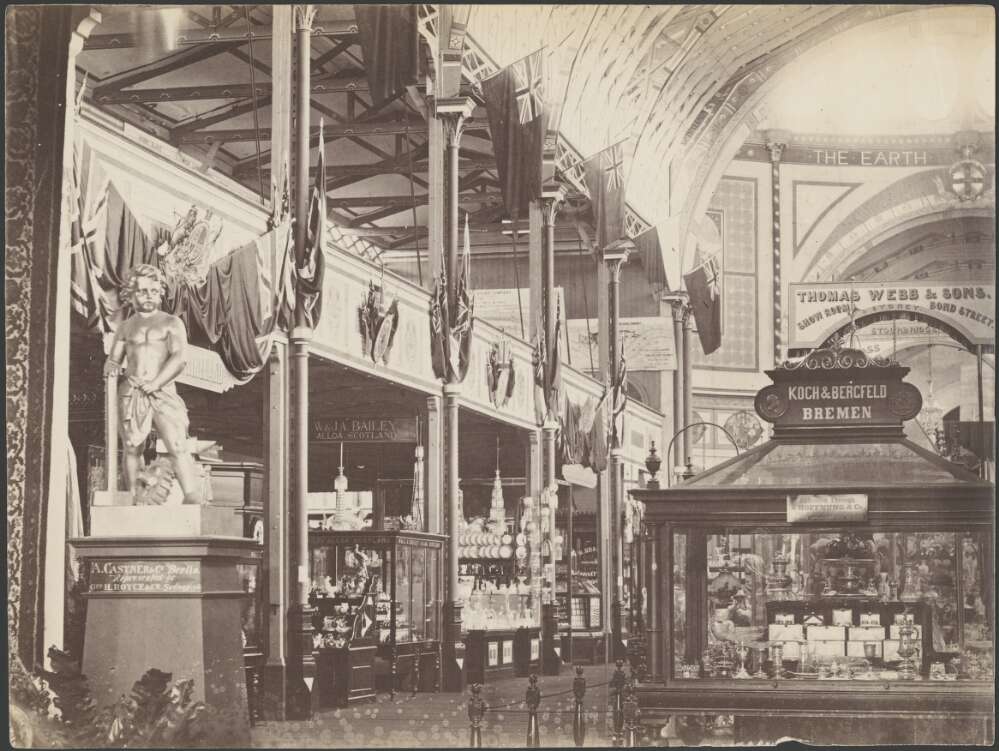
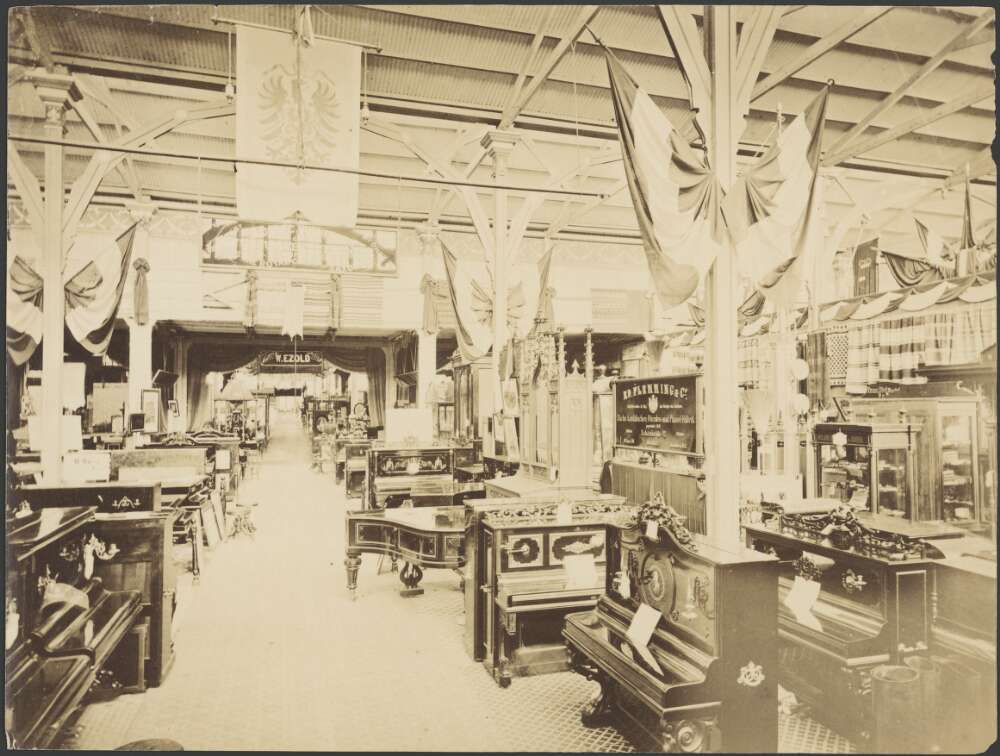
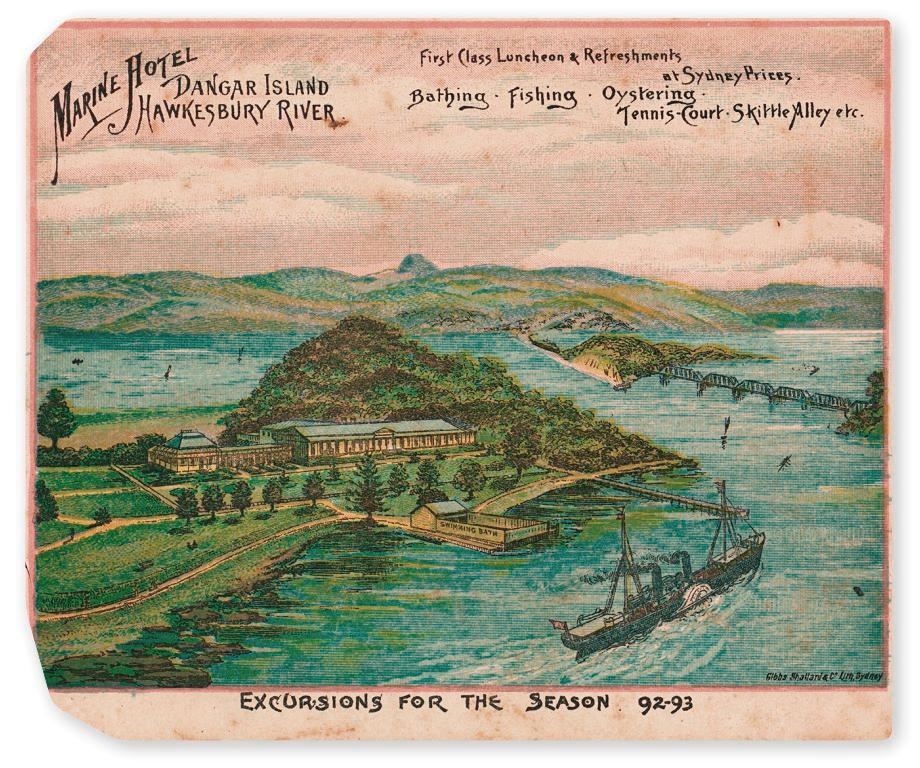
The Junction Reefs dam on the Belubula River is part of the Old Junction Reefs Gold mine complex and was the next project.
Quote from -International Database for Civil and Structural Engineering-
 "The dam is located at Junction Reefs, New South Wales, Australia, about 7 km North-West of Lyndhurst. It is located on the Belubula River, 500-m upstream of its confluence with the Mandurma Ponds.
"The dam is located at Junction Reefs, New South Wales, Australia, about 7 km North-West of Lyndhurst. It is located on the Belubula River, 500-m upstream of its confluence with the Mandurma Ponds.
[It was] Built to supply hydropower to the mining company. Four Pelton wheels were supplied in water by the reservoir.
Built between 1895 and 1897, completed in 1897, the Junction Reefs dam is a concrete-brick multiple arch dam: it is 18.3-m high with a 131-m long crest. There are 5 elliptical arches, with a 8.5-m span each and a 60-degrees lean, sitting on 6 buttresses.
The dam foundation and the outside walls are made of concrete. The arches and buttresses are brick works. The original storage capacity was 2,467,000 m³. The dam was equipped with a large scour outlet system and a pipe inlet to supply the Pelton wheels. The scour tunnel was protected by an earth embankment and a screen system. The main spillway is an unlined rock stepped cascade on the left bank (4 to 8 steps) (Q ~ 38 m3/s) and an emergency overflow is located over the 5 arches (Q ~ 15 m3/s). Original drawings indicate that the spillway cascade was gated (SCHULZE 1897). Today it is ungated. The reservoir was silted considerably during the floods following the Great Drought of 1900-1902. Efforts were made to desilt the reservoir in the 1930s, by inserting explosives in the scour tunnel. They were not completely successful and the reservoir never regained its original capacity. The reservoir is fully silted today.
The Junction Reefs dam was the first multiple-arch dam in Australia. The second one was at Great Lake reservoir (Launceston, New South Wales, 1922).
At Junction Reefs, brick construction was selected as the cheapest and quickest material to build for the arches , concrete being cheaper only for the foundation (SCHULZE 1897). [There was presence of good clay for brick-making near the dam site.] Curiously the original design included 6 arches but the final design had only 5 arches because of delays in the brick-making. The arches were designed in the same way as bridge (or culvert) arches, and the buttresses were calculated as bridge piers. ["The arches were calculated in the same way as bridge [...] and the buttresses as bridge piers" (SCHULZE 1897, p. 171)."
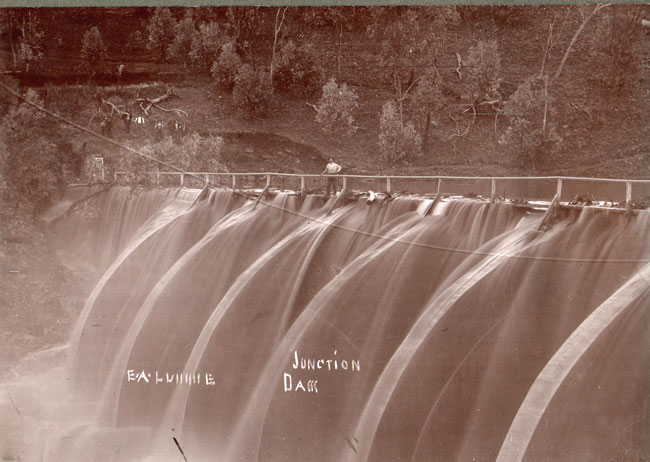
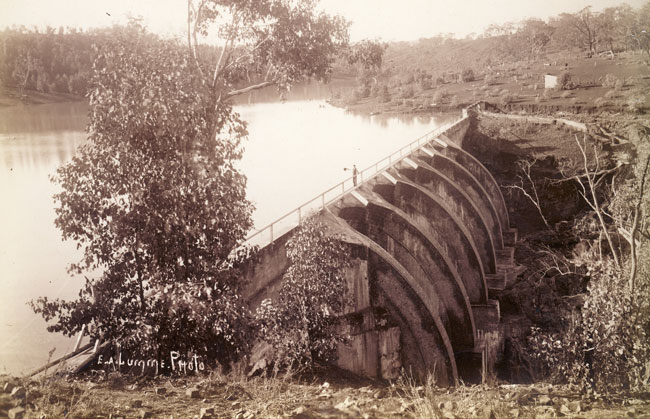
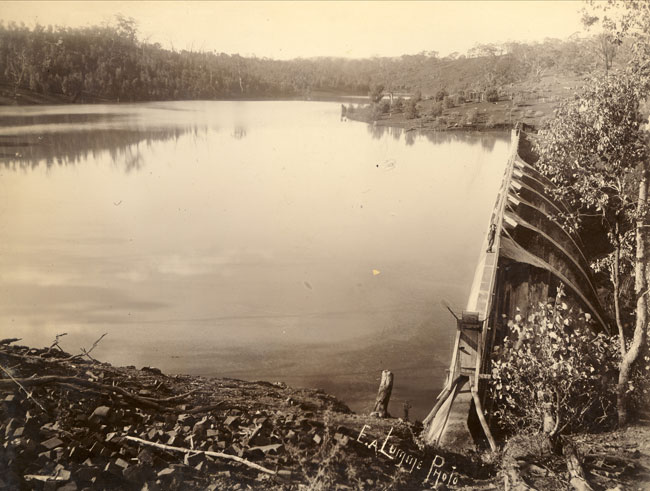
Belubla river dam from and by Evan Antoni Johann Lumme (1865-1935) from Mandurama photograph collection - held by National Library of Australia - E.A. Lumme was born in Estonia and after several years as a sailor, arrived in Australia in 1889. He worked as a professional photographer in Sydney and moved to the Lyndhurst area in 1900.
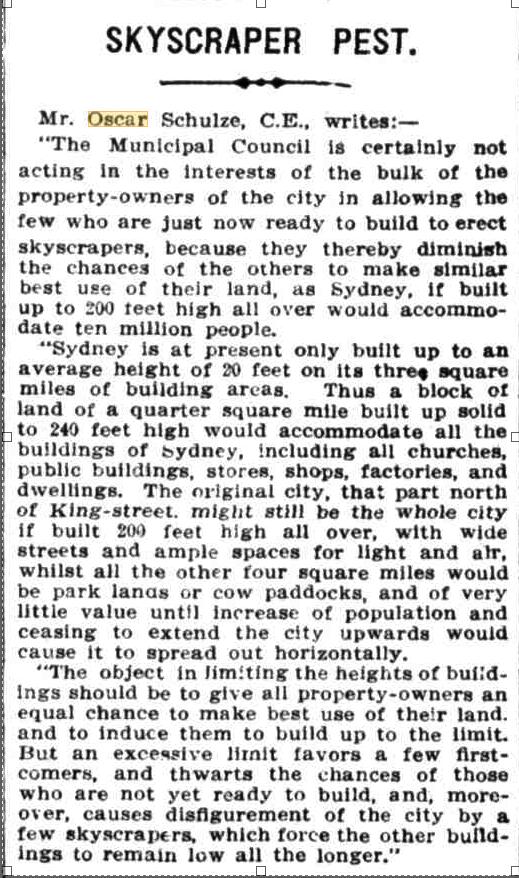
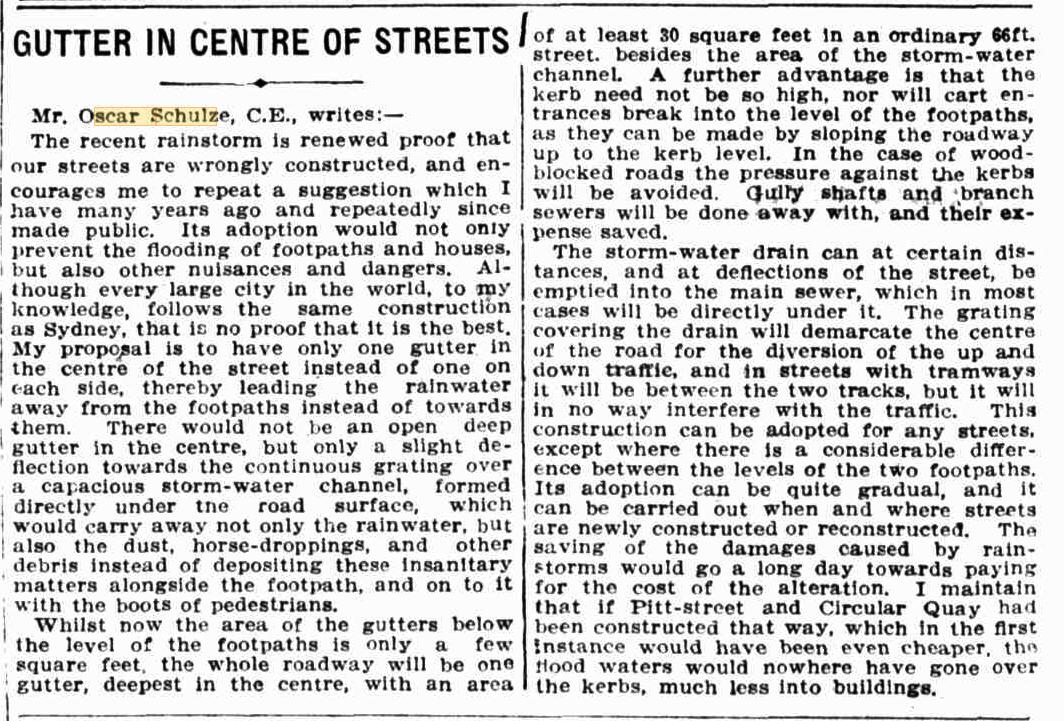
SCHULZE. — April 4, 1919, at his residence, Basing-stoke, Musgrave-street, Mosman, Carl Oscar Schulze, C.E., of pernicious anaemia, in his 71st year. Privately interred, April 5, at Gore Hill. Family Notices (1919, April 7). The Sydney Morning Herald (NSW : 1842 - 1954), , p. 6. Retrieved from http://nla.gov.au/nla.news-article15833137
